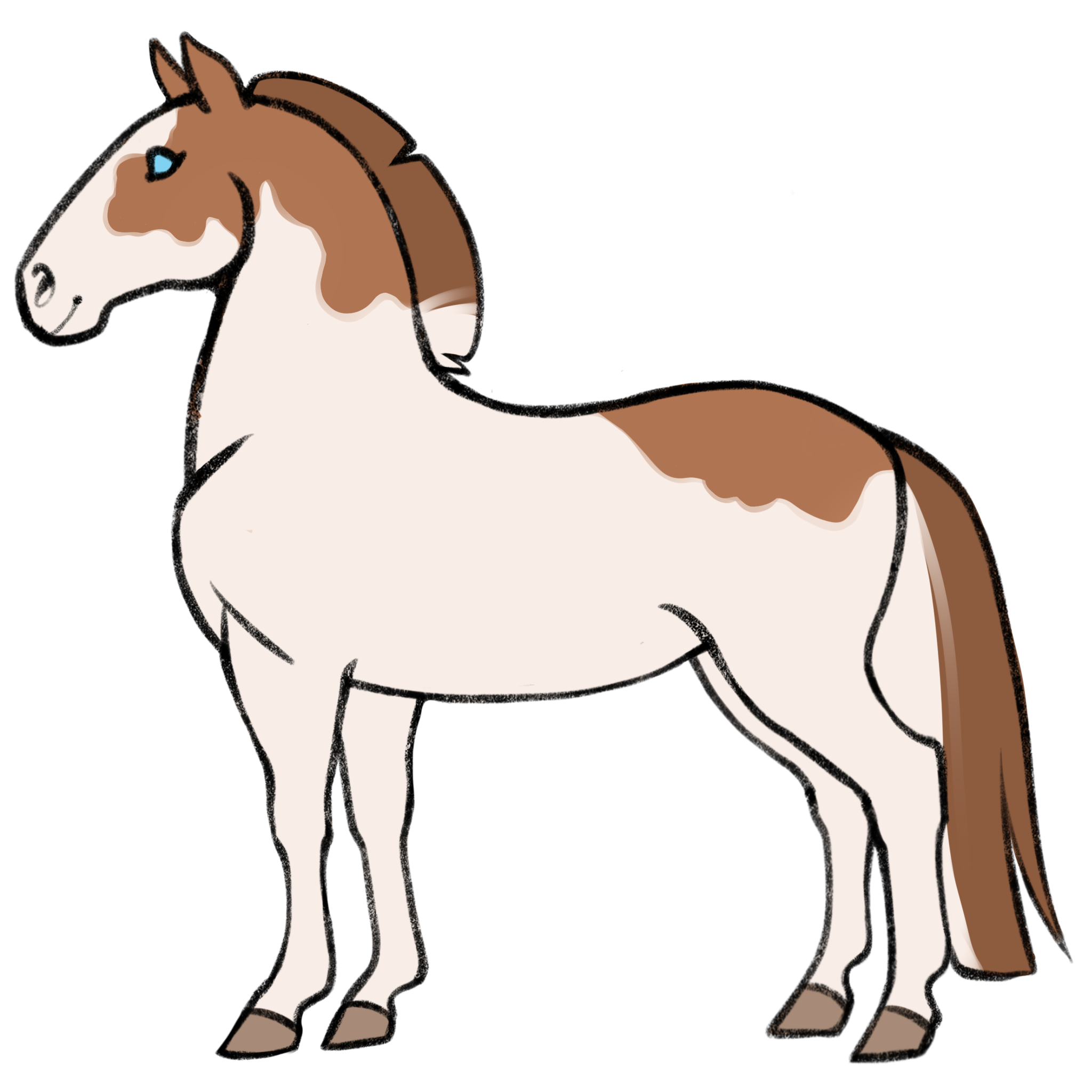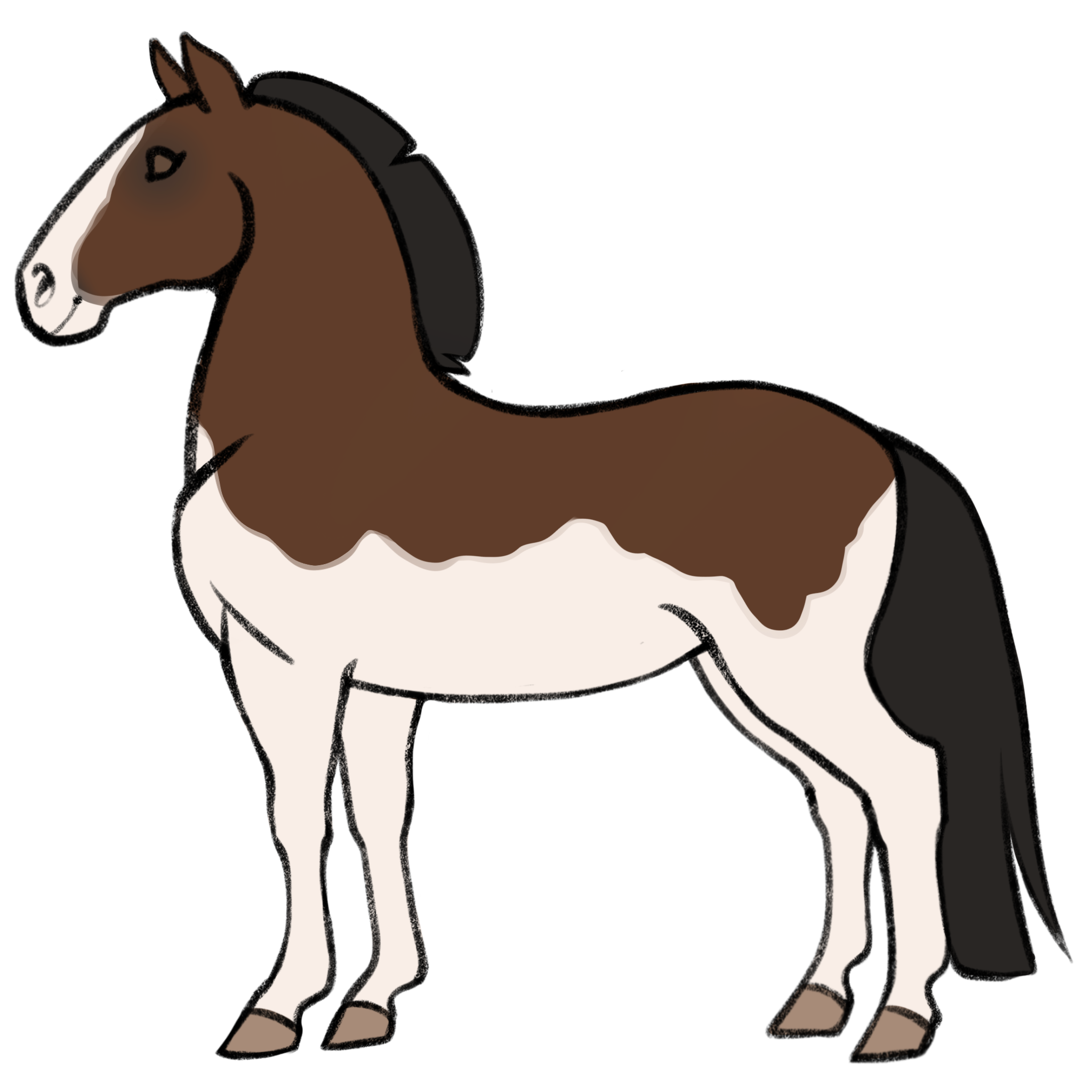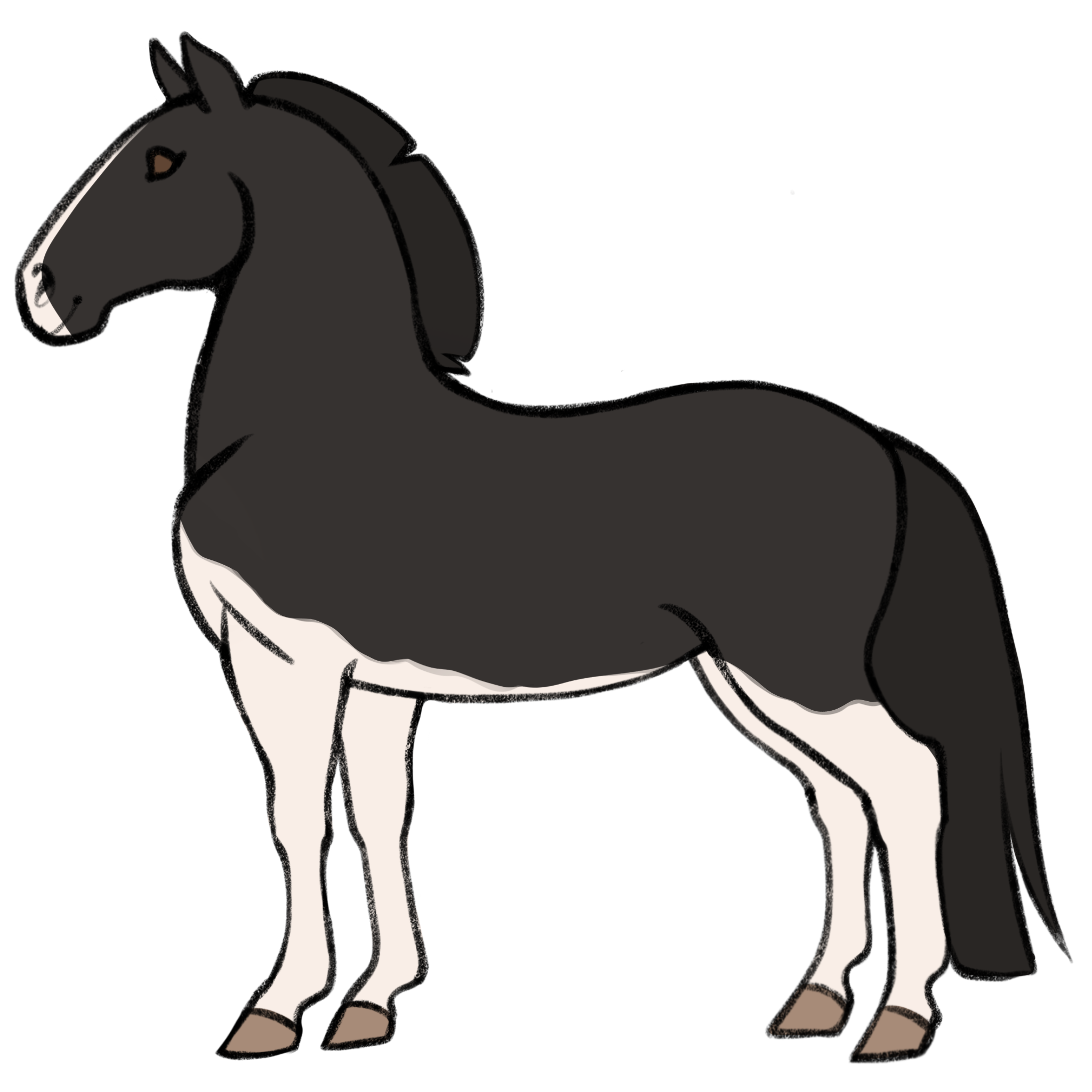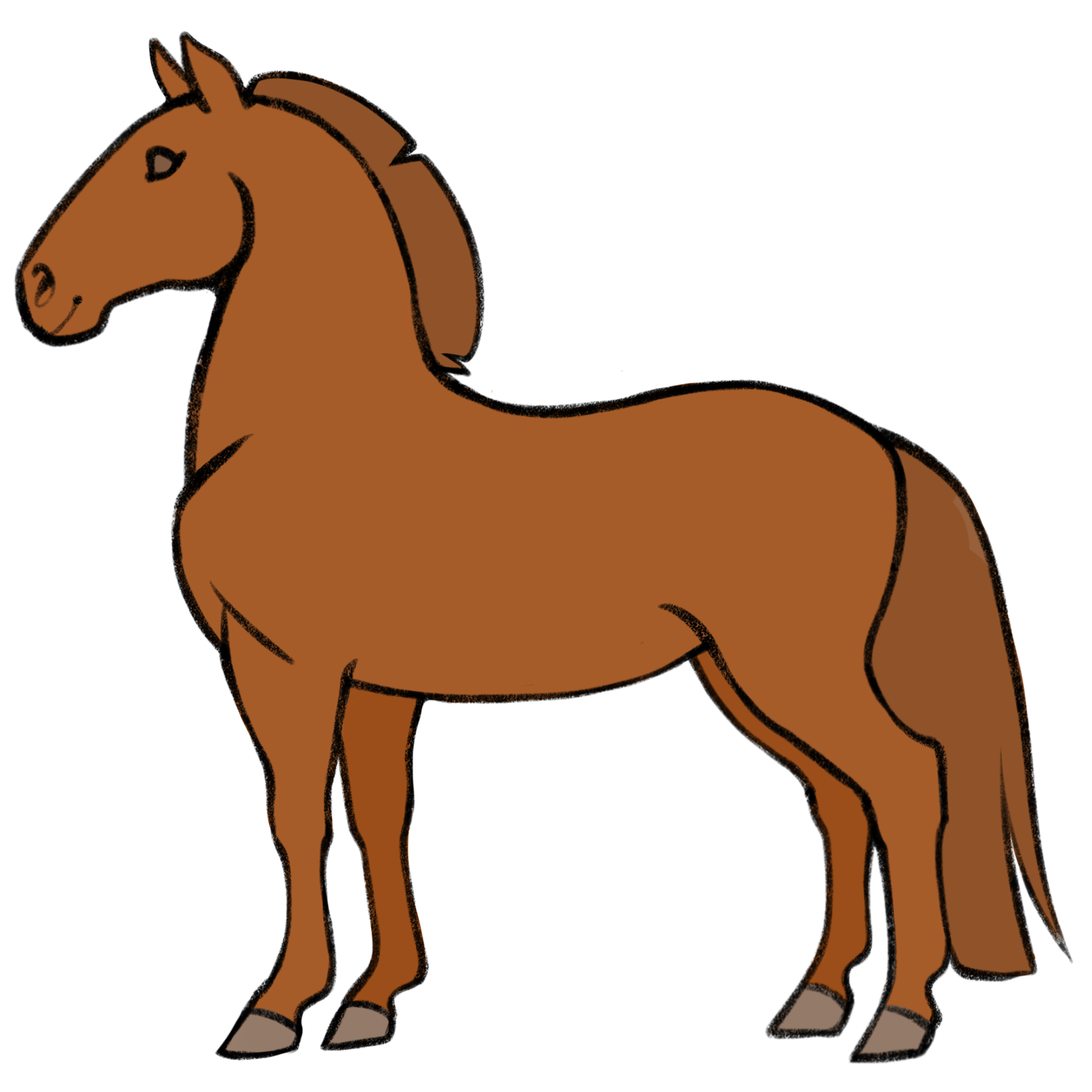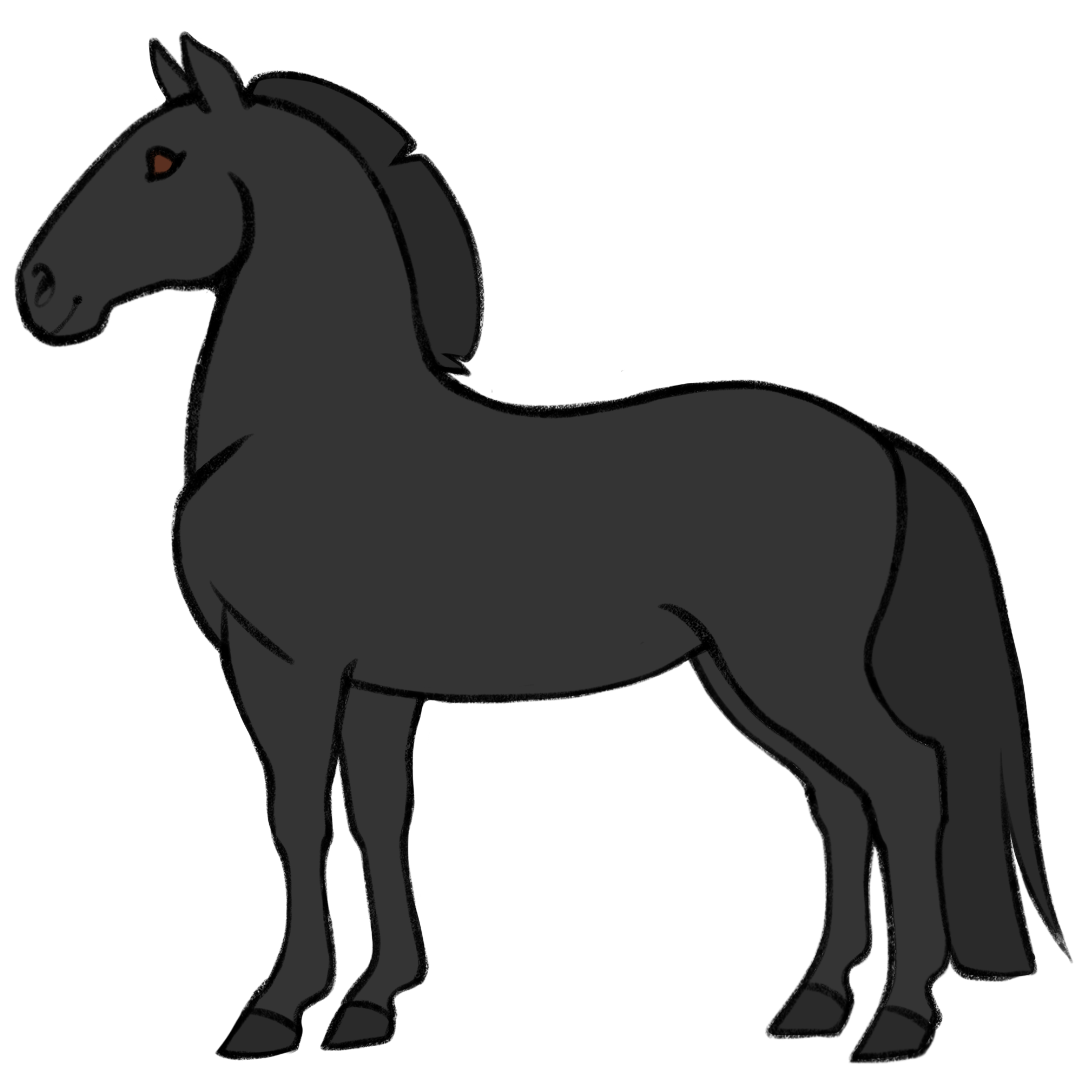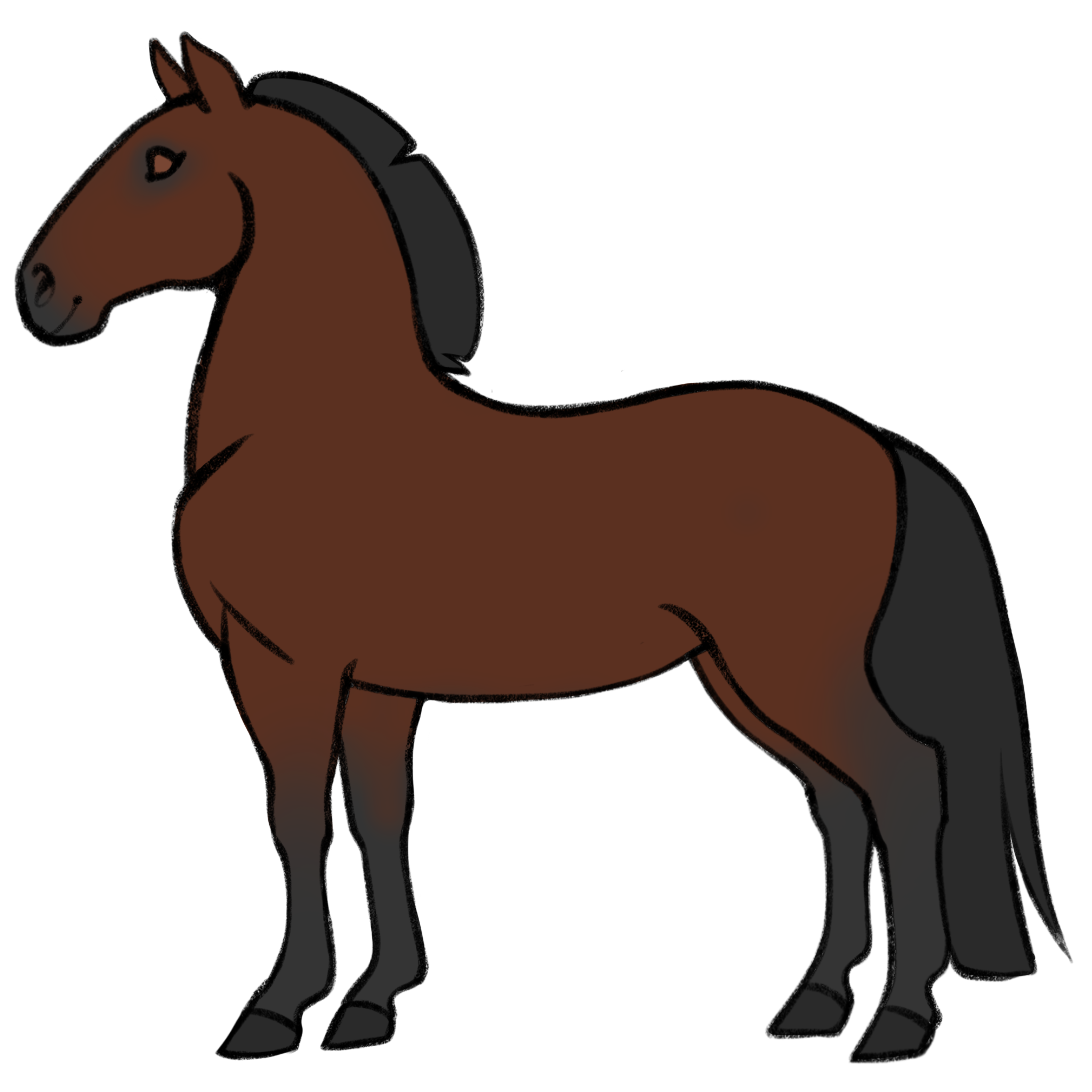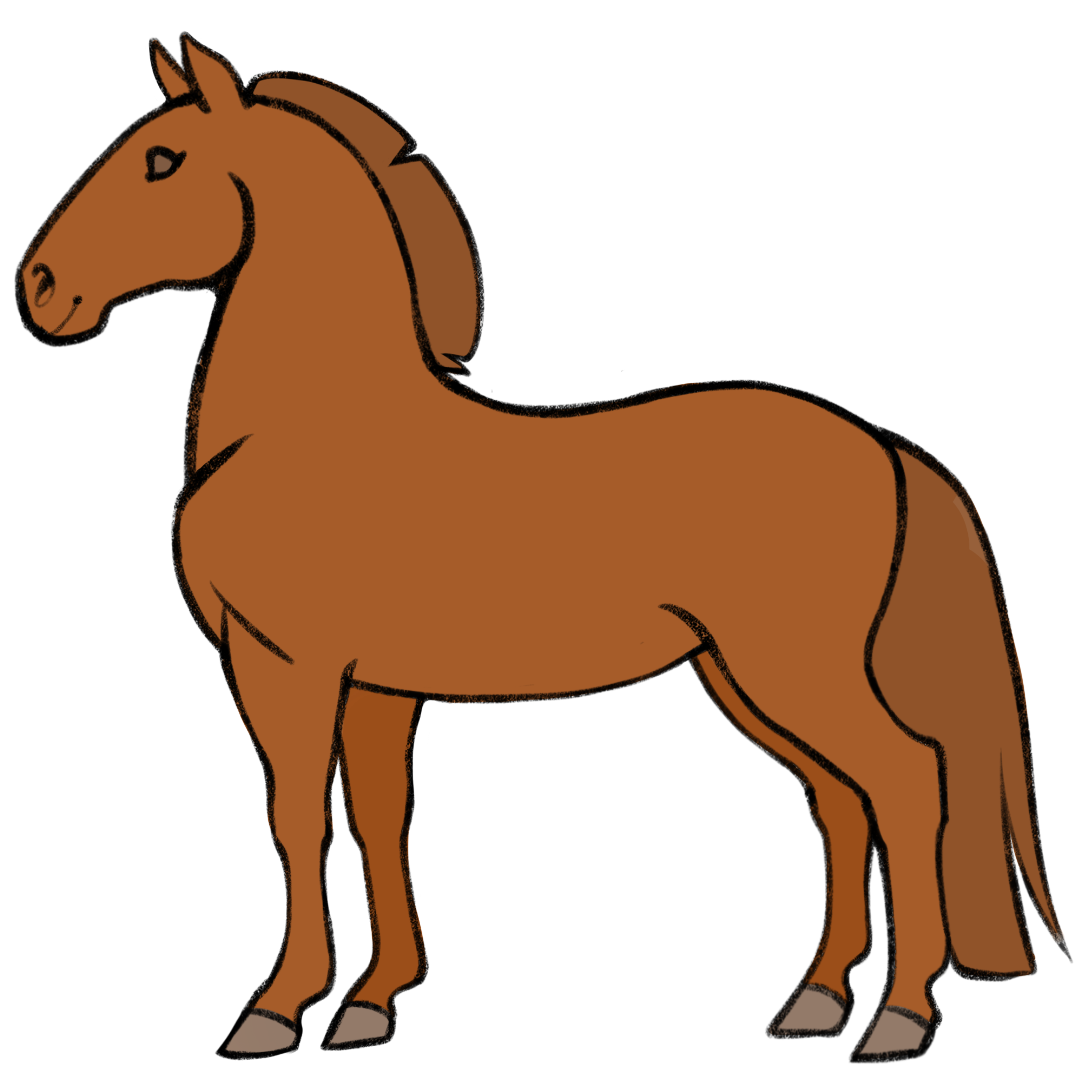Traits
(ee A_) chestnut, hidden agouti (Natural)
Name: Chestnut, Hidden Agouti
Base Genotype: ee A_
Skin Color: Light
Eyes: Brown
Description: Chestnut, sometimes referred to as Sorrel or simply "Red" is the coat color that occurs when the horse carries no Eumelanin, which creates black pigment. Additionally, the Agouti gene restricts that black pigment to the mane, tail, and legs- but since a chestnut horse has no Eumelanin (two e's), there is no way to tell if the horse is carrying a copy or two of Agouti. Therefore, these horses are agouti carriers and may have offspring that are able to show the Agouti gene. (These horses are usually bay.)
Like most base coats, intensity can vary. Chestnut ranges from a brassy ginger color all the way to "Liver Chestnut" - a dark, chocolatey brown.
The hidden Agouti gene does not impact the appearance of chestnut in any way.



(E_ aa) black (Natural)
Name: Black
Base Genotype: E_, aa
Skin Color: Dark
Eyes: Brown
Description: While some dark brown coats are mistaken for black, true black horses have coats that do not sunbleach or fade to brown. These horses typically have dark skin and brown eyes and a solid black coat that covers the entire body. Note that black horses have no copies of Agouti (they have two little a's, no big A's) since the Agouti gene would restrict the black pigment (E_) to the legs, mane, and tail- thus making a Bay horse instead of a Black horse.
When colorpicking for a solid black coat, it's required that the black is lighter than the black used for the lineart.
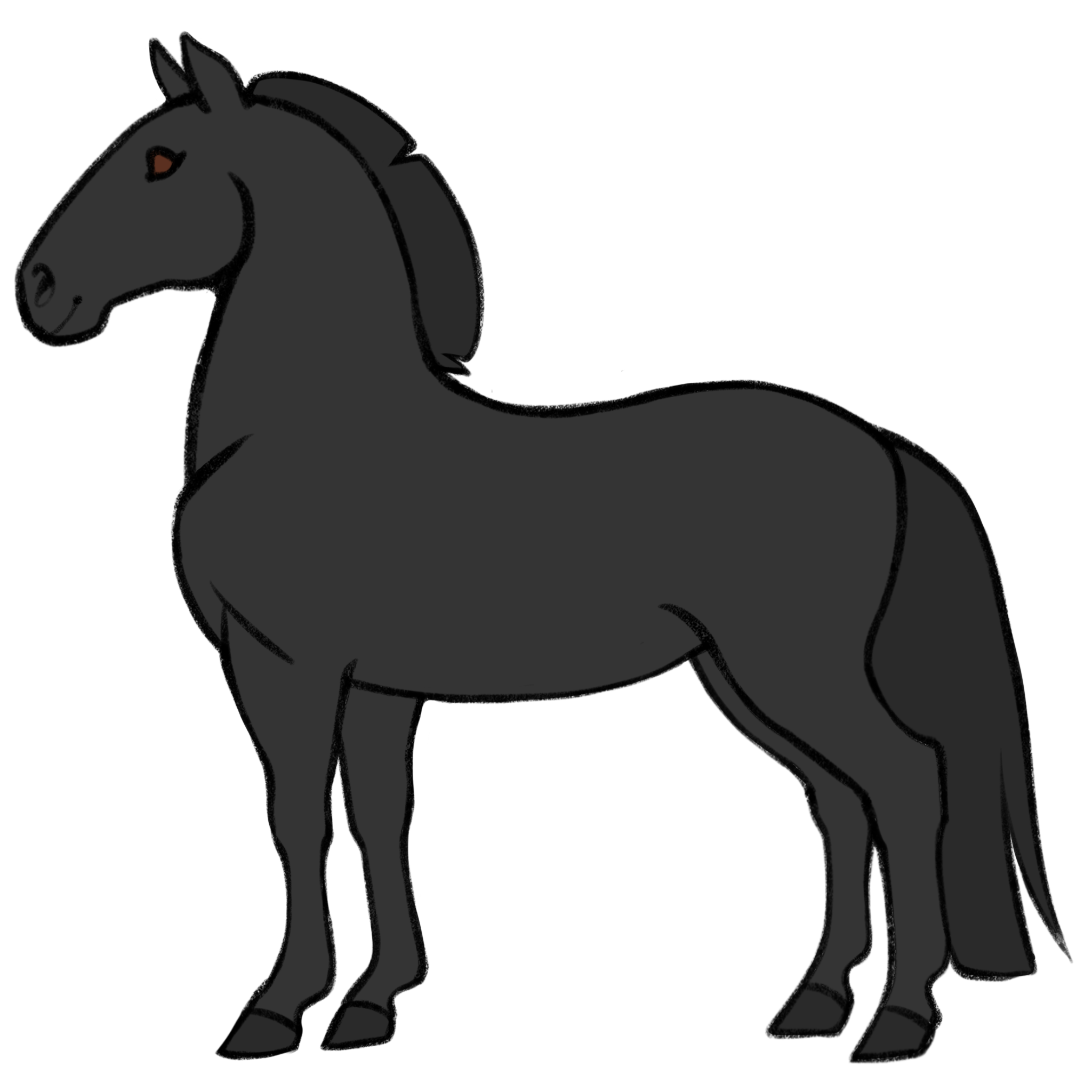
(E_ A_) bay (Natural)
Name: Bay
Base Genotype: E_, A_
Skin Color: Dark
Eyes: Brown
Description: The Bay coloration is requires that the horse is capable of producing black pigment (has at least one big E) and has the Agouti gene that restricts that black pigment to the mane, tail, and legs (has at least one big A). Bay horses have many variations in hue, such as "Bright" bays and "Blood" bays. There are also two optional variations of the Bay gene: "Brown" and "Wild" - these examples are shown below.
Design Guidance:
Horses that are eligible for bay coats can have a wide range of color available to them, ranging from a solid dark brown that could nearly be mistaken for black, to a bright wild bay that nearly looks dun. It's important not to clearly overlap those other colors. Blood bay horses should take care not to be so saturated as to look like an Ember Bay.
All examples below.
Standard Bay (E_, A_) Variations:

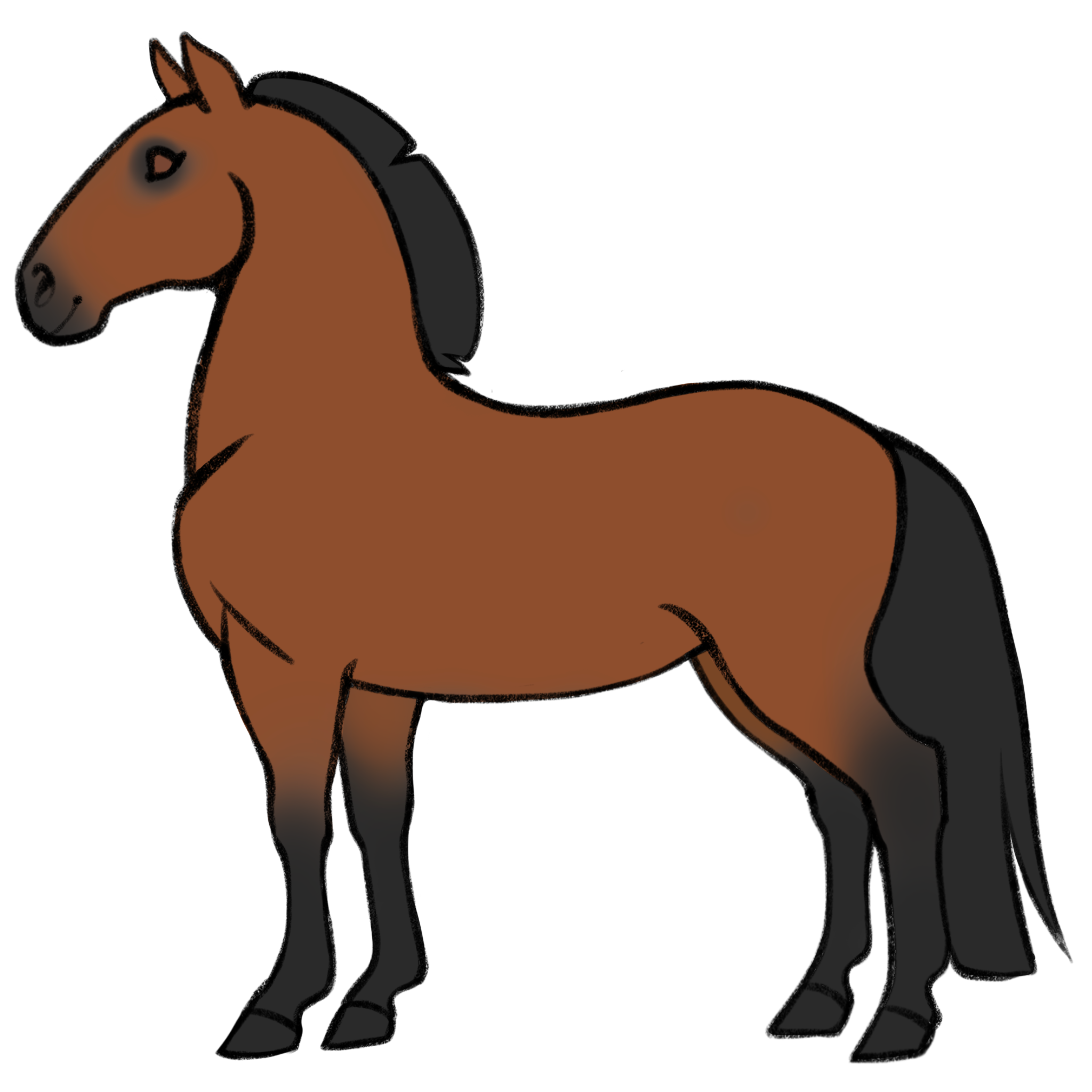

Brown (E_, At) Variation:
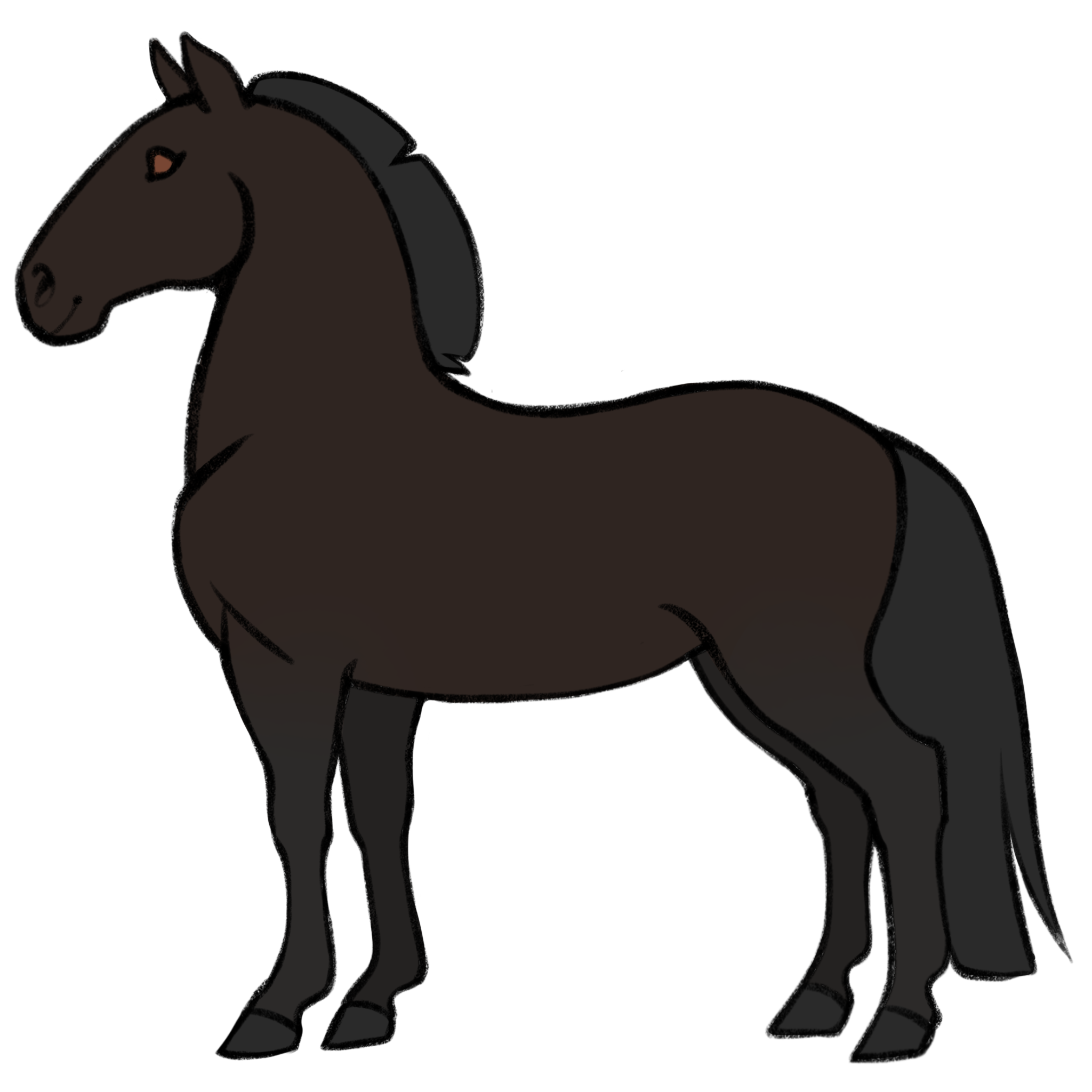
Wild Bay (E_, A+) Variations:
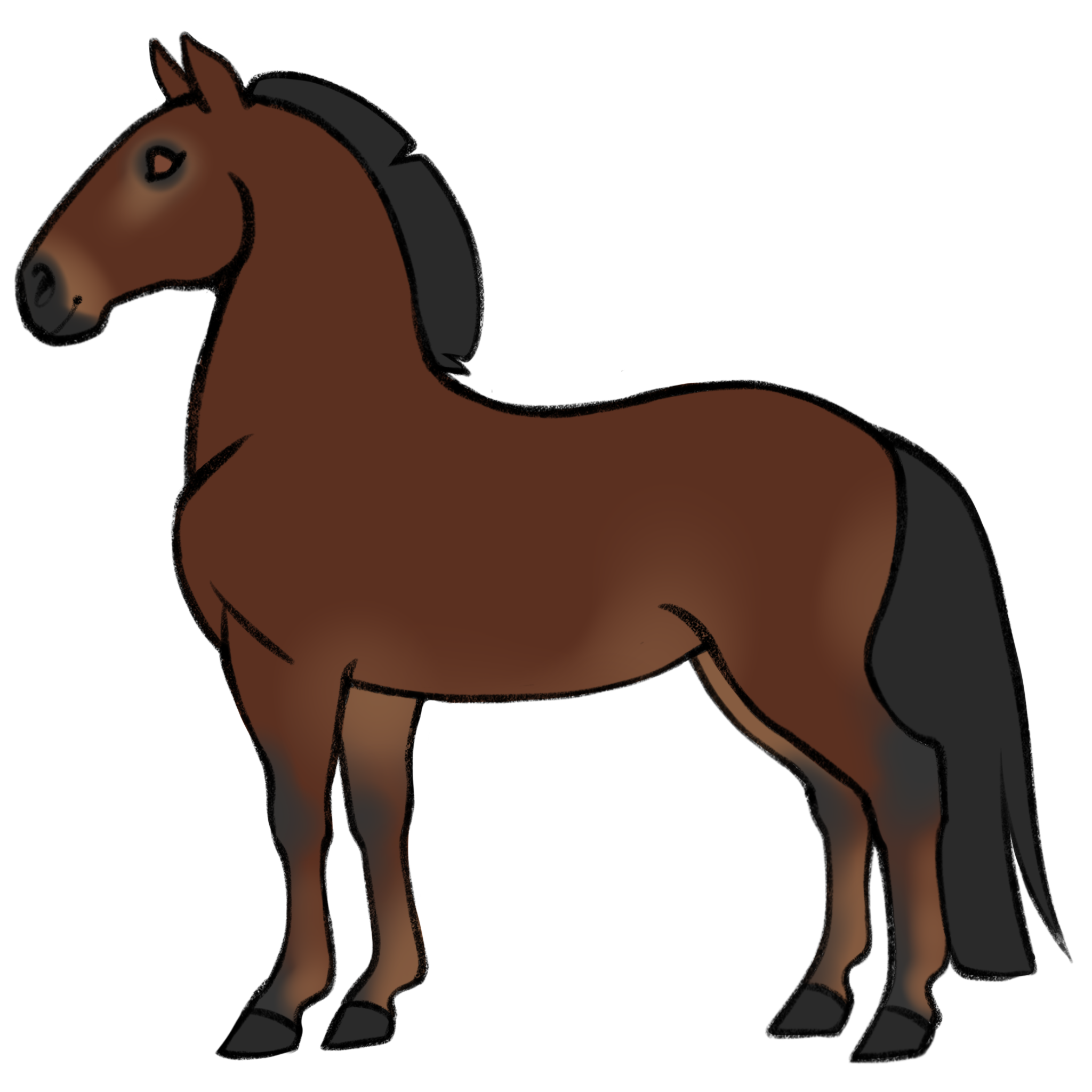

(ee aa) chestnut, no agouti (Natural)
Name: Chestnut, No Agouti
Base Genotype: ee aa
Skin Color: Light
Eyes: Brown
Description: Chestnut, sometimes referred to as Sorrel or simply "Red" is the coat color that occurs when the horse carries no Eumelanin, which creates black pigment, and no Agouti, which restricts that black pigment to the mane, tail, and legs.
Like most base coats, intensity can vary. Chestnut ranges from a brassy ginger color all the way to "Liver Chestnut" - a dark, chocolatey brown.



(Z_) silver (Natural)
Name: Silver
Base Genotype: Z_
Skin Color: Dark
Eyes: Brown
Description: Silver impacts black pigment, pushing it towards grey or white. As such, chestnut horses can carry silver, but will never show it since they do not make black pigment. Silver is a dominant gene, so it requires only one copy to be visible on bay and black horses.
Design Guidance:
Horses will have greying of the mane and tail at minimum. Bay horses can have greying legs in addition to the mane and tail if desired. Black horses can optionally have strong grey dapples and greying legs or neither.
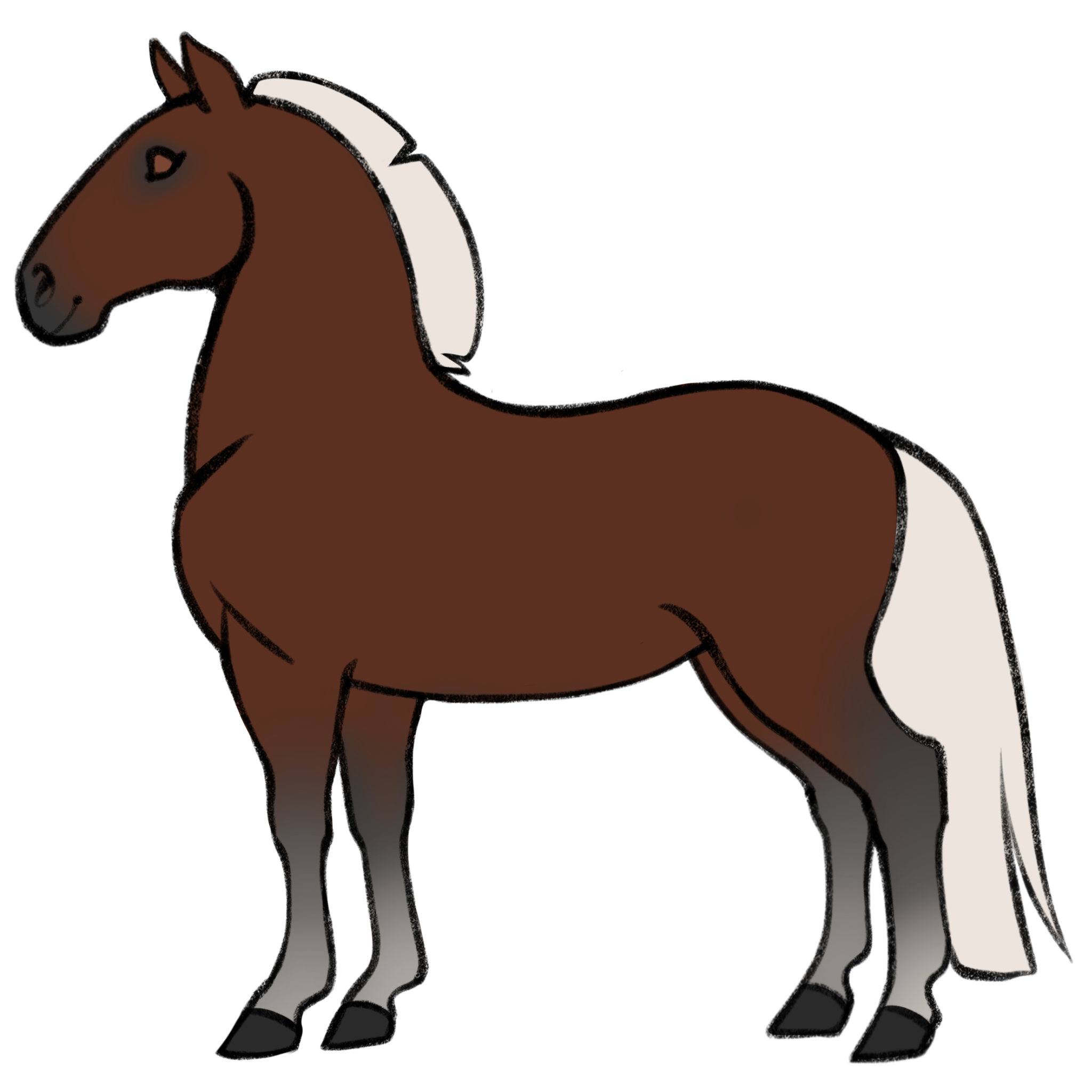
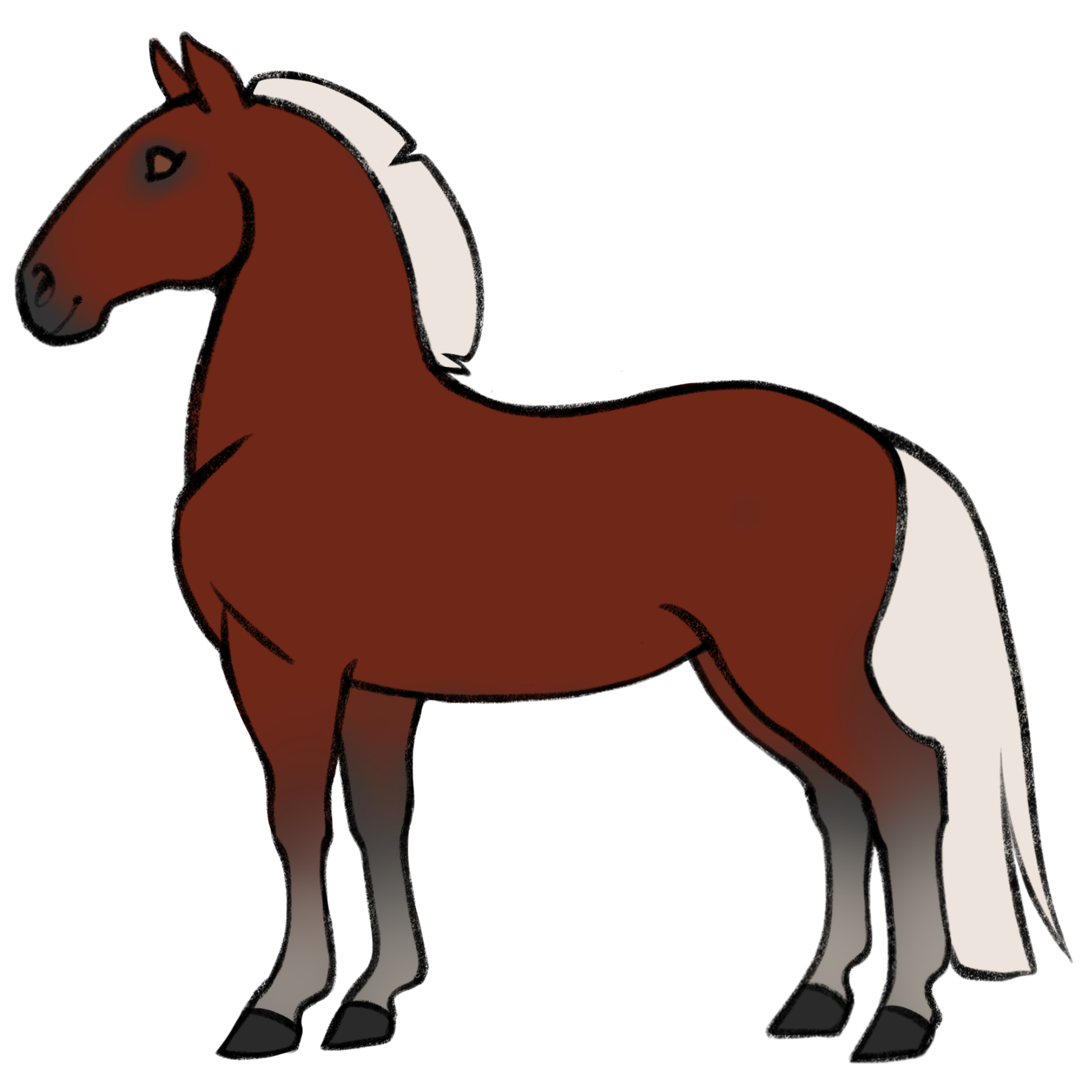

(ff) flaxen (Natural)
Name: Flaxen
Base Genotype: ff
Skin Color: Light
Eyes: Brown
Description: Flaxen affects chestnut horses only and causes the mane and tail to lighten to a bright gold, blonde, or light cream color. Flaxen is recessive, meaning that it will show only if the horse has two "little f's" - two recessive copies. If the horse has (Ff) then they will be a Flaxen carrier. Bay and Black horses can also carry or have hidden flaxen.
Design Guidance:
Horses will have a slightly lighter mane and tail at minimum. At the most maximal, their mane and tail would be off-white cream in color, but not pure white. (Must be warm toned.) Liver chestnut horses can also have very contrasting mane and tail, such as the example below.


(STY_) sooty (Natural)
Name: Sooty
Base Genotype: STY_
Skin Color: Dark
Eyes: Brown
Description: Sooty affects all base coats and darkens the coat starting along the back and topline. Sooty has a wide range of expression and may range from barely being noticable at all, to covering a large portion of the body and causing strong dappling on the horses neck, shoulders, and sides. Even on lighter coats like champagne or cream, some darkening of the coat will occur. On bay horses, the sooty areas tend to be black. On black horses, sooty is not able to be seen.
Design Guidance: Sooty should be a blended out gradient without hard edges, with the strongest darkening being along the horse's topline. At minimum, sooty can very slightly darken the spine of the horse. At maximum, the sooty can darken the entire body of the horse and blend out down the legs. Sooty does not make horses solid black, or solidly darkened- it should be a gradient. Sooty does not have any impact on white markings such as tobiano or sabino, as sooty occurs below these markings. Sooty dapples are optional.

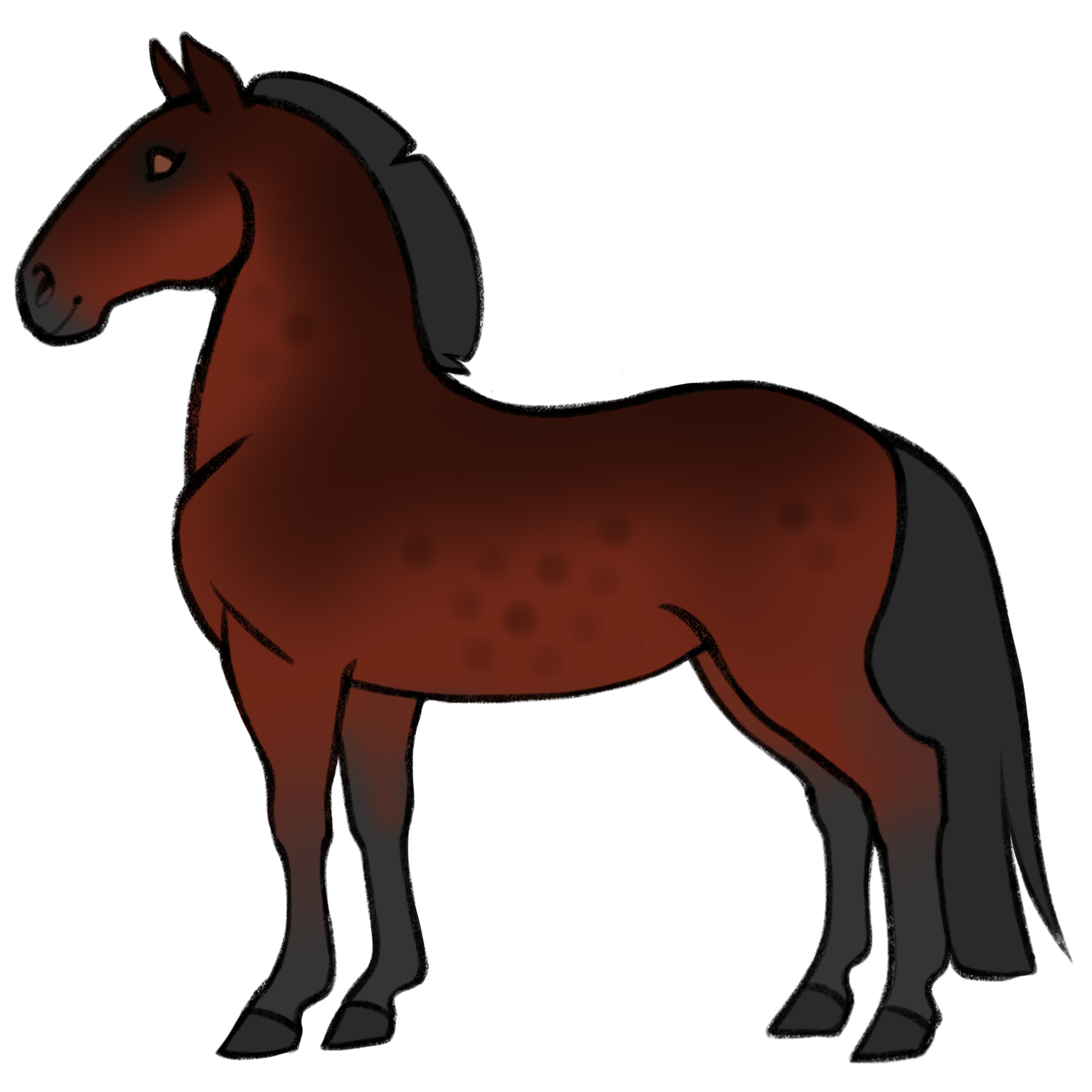
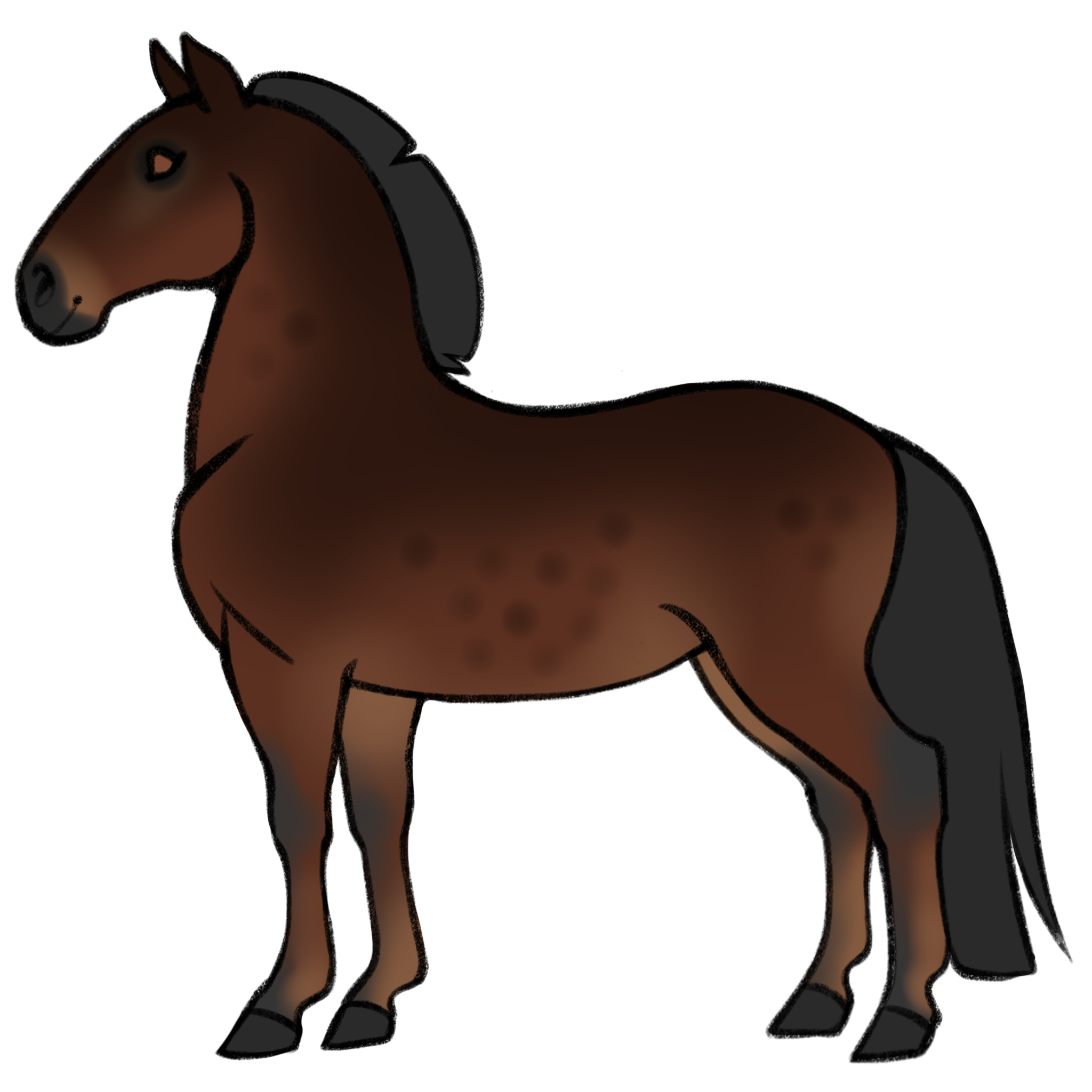
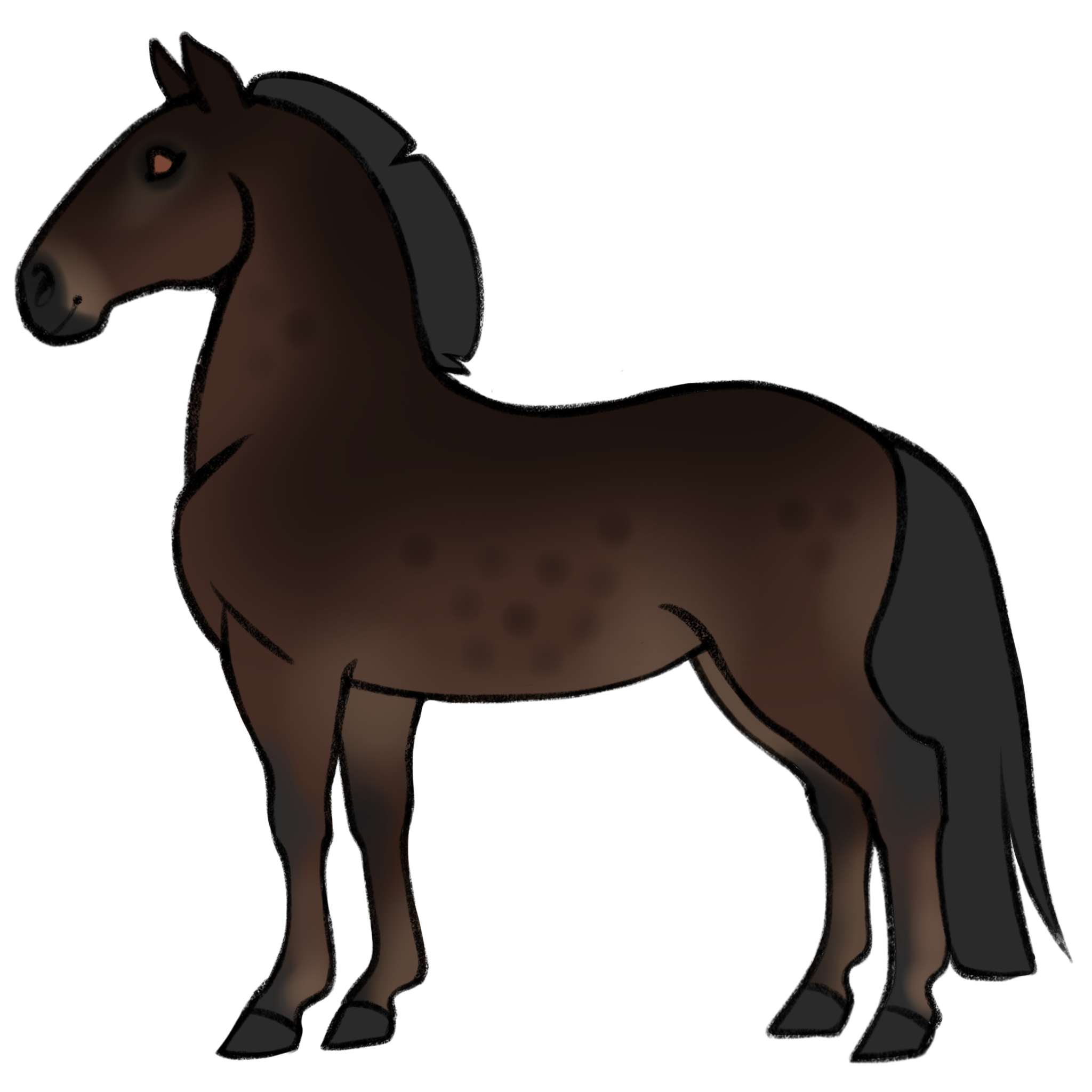
On light diluted coats, be sure to only darken the coat, rather than using black to blacken it. Here we have a sooty pearl horse where the pearl coat is darkened by sooty:

(PNG_) pangaré (Natural)
Name: Pangaré
Base Genotype: PNG_
Skin Color: No Effect
Eyes: No Effect
Description: Pangaré is a type of countershading that is visible on all base coats except black. That is to say, pangaré lightens any red-based hairs on the underside of the horse, most noticeably where the skin is thinnest. Sometimes Pangaré Bay horses are referred to as being "Mealy Bay." Pangaré is a dominant gene, so only one copy is needed for it to show.
Design Guidance: Pangaré at minimum will slightly lighten the muzzle and armpits of the horse. At maximum, the muzzle, eyes, insides of the legs, and the undersides of the neck, barrel, and flank are all lightened. Pangaré is a lightening of the existing base coat, but can introduce warm tones. Pangaré and Sooty together on the same horse usually causes dramatic shading and dappling. In the real world, Pangaré is most commonly found in Prezwalski's horses, draft horses, mules, and primitive horse breeds. These can all be good sources of reference.
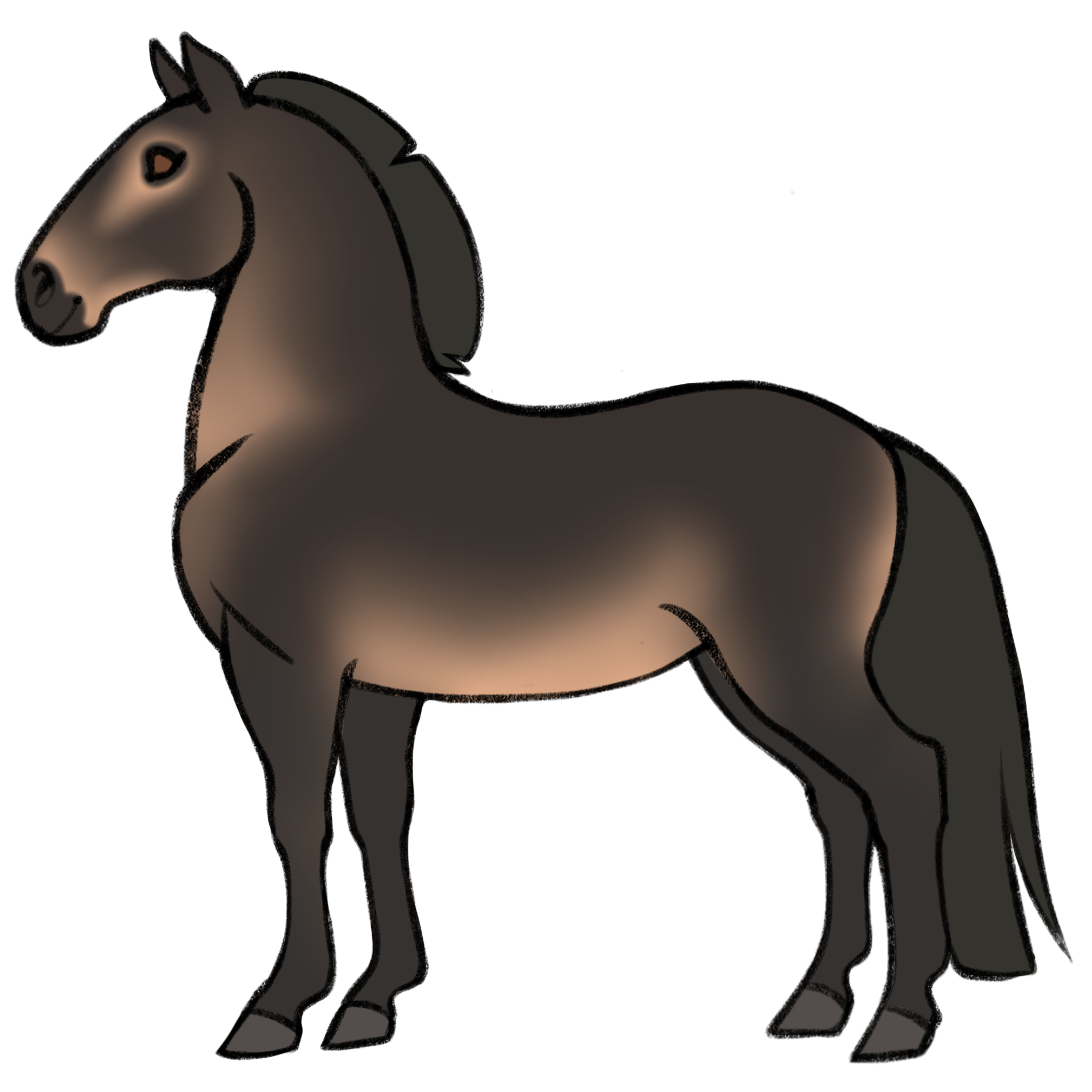
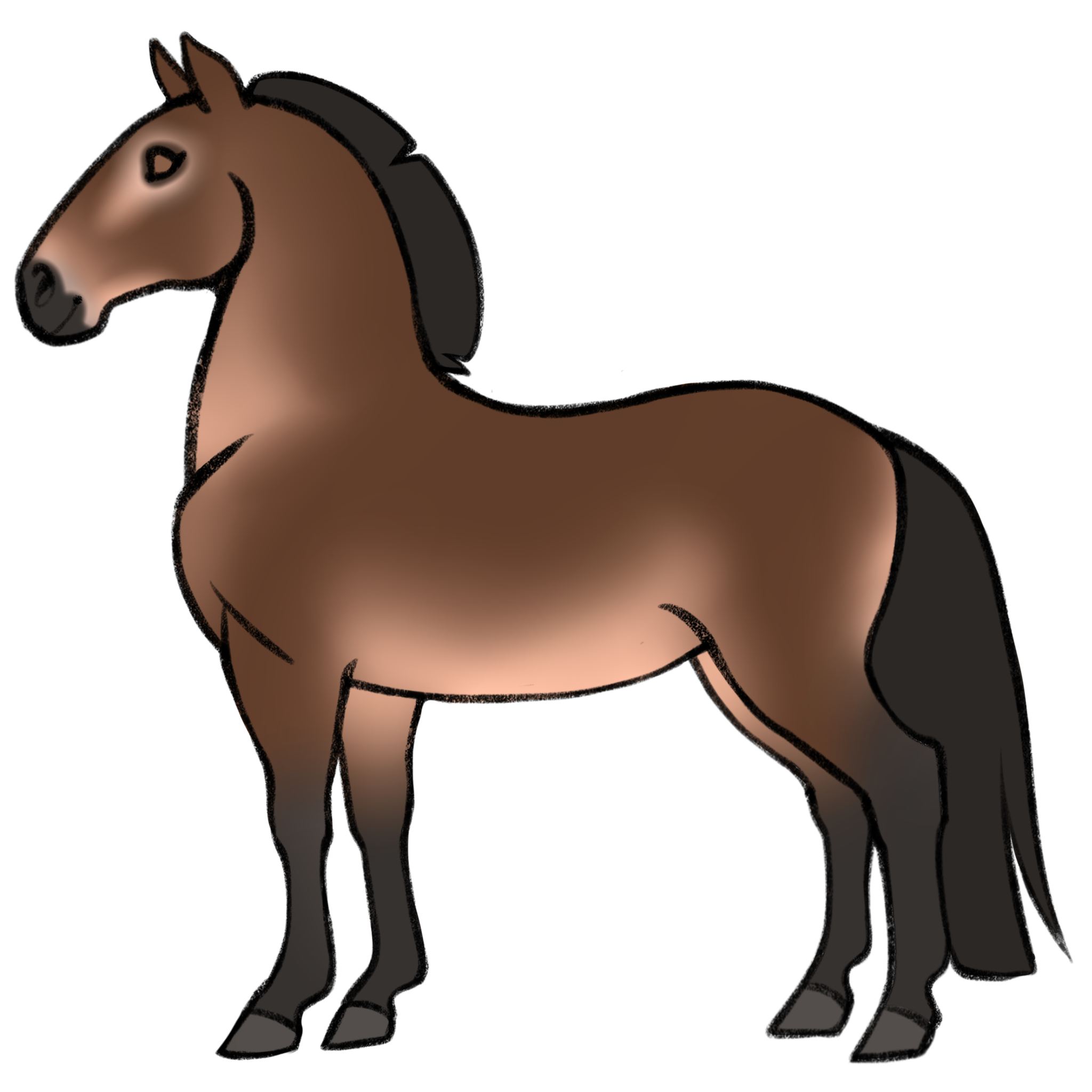
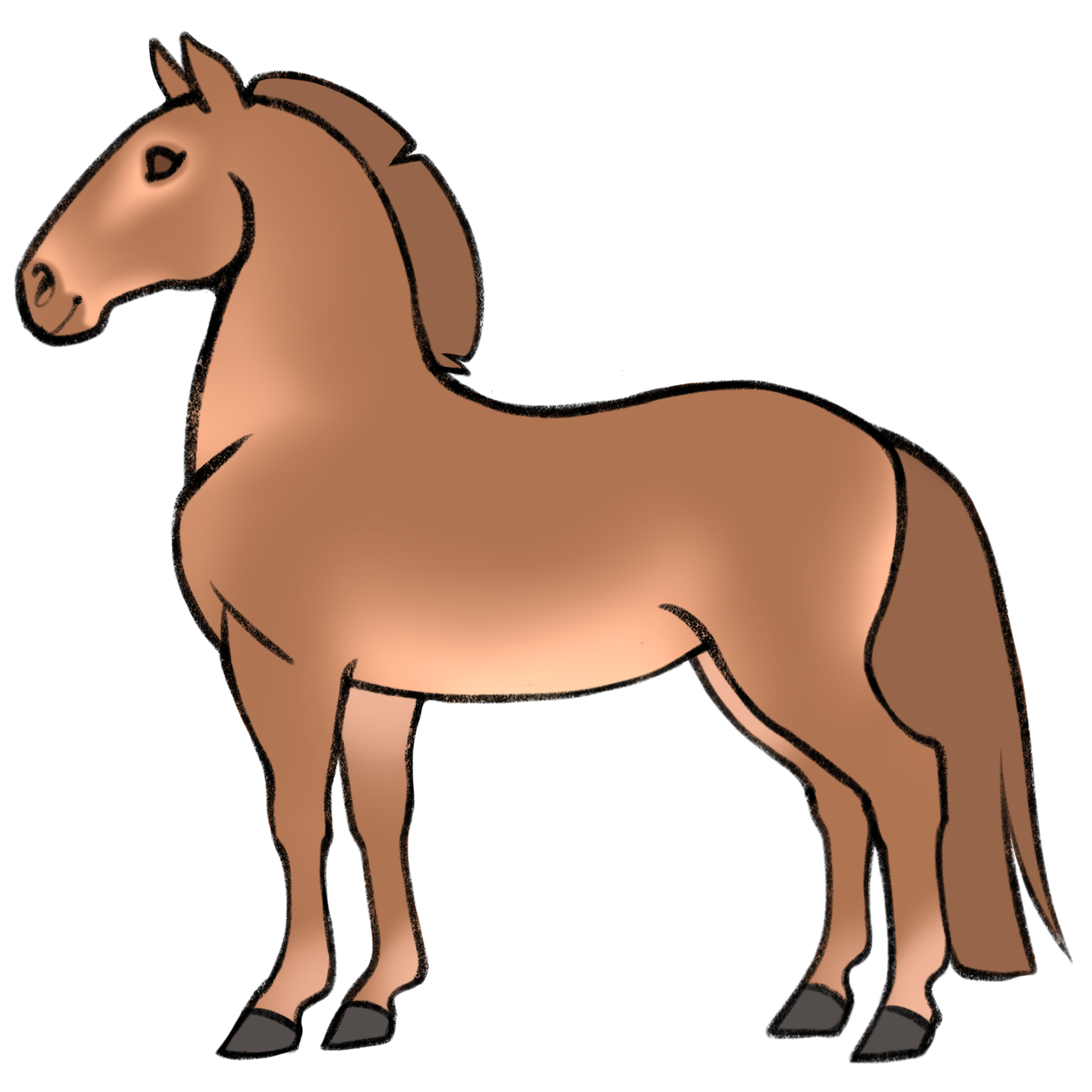
(CRCR) double cream (Natural)
Name: Double Cream
Base Genotype: CRCR (on the same locus as Champagne and Pearl)
Skin Color: Turns skin pink, regardless of base coat.
Eyes: Turns both eyes blue, unless a horse has an eye color gene such as Oracle, Arcane, or Tiger eye. If an eye color gene is present, it takes precedence and is visible.
Description: Cream lightens the red pigments in the coat, and is an Incomplete Dominant gene. This means that one copy of cream (CRn) will look different from a horse with two copies of cream (CRCR), with Double Cream causing even more lightening of the coat color and causing hoof color to lighten. While single cream does not affect black pigment, double cream does. If combined with another dilution copy on the same locus, such as pearl (CRprl) or champagne (CRCR CH_) it will cause the horse appear as a double dilute very similar to double cream. Double Cream has several names for it's variations, which can all be searched on for real-life references:
- "Cremello" : a chestnut horse with double cream.
- "Perlino" : a bay horse with double cream (not to be confused with a pearl horse!)
- "Smoky Cream" : when a black horse has double cream.
Design Guidance: Double cream lightens the horse to an extreme degree and should have a slight yellow tone. It will make all hooves light in color. Double cream does not make horses pure white. Horses may have slighty different variations of the examples below, but not by much. Colorpicking is encouraged. Cream does interact with Grim and Ember; see dilution guides on their respective trait pages.
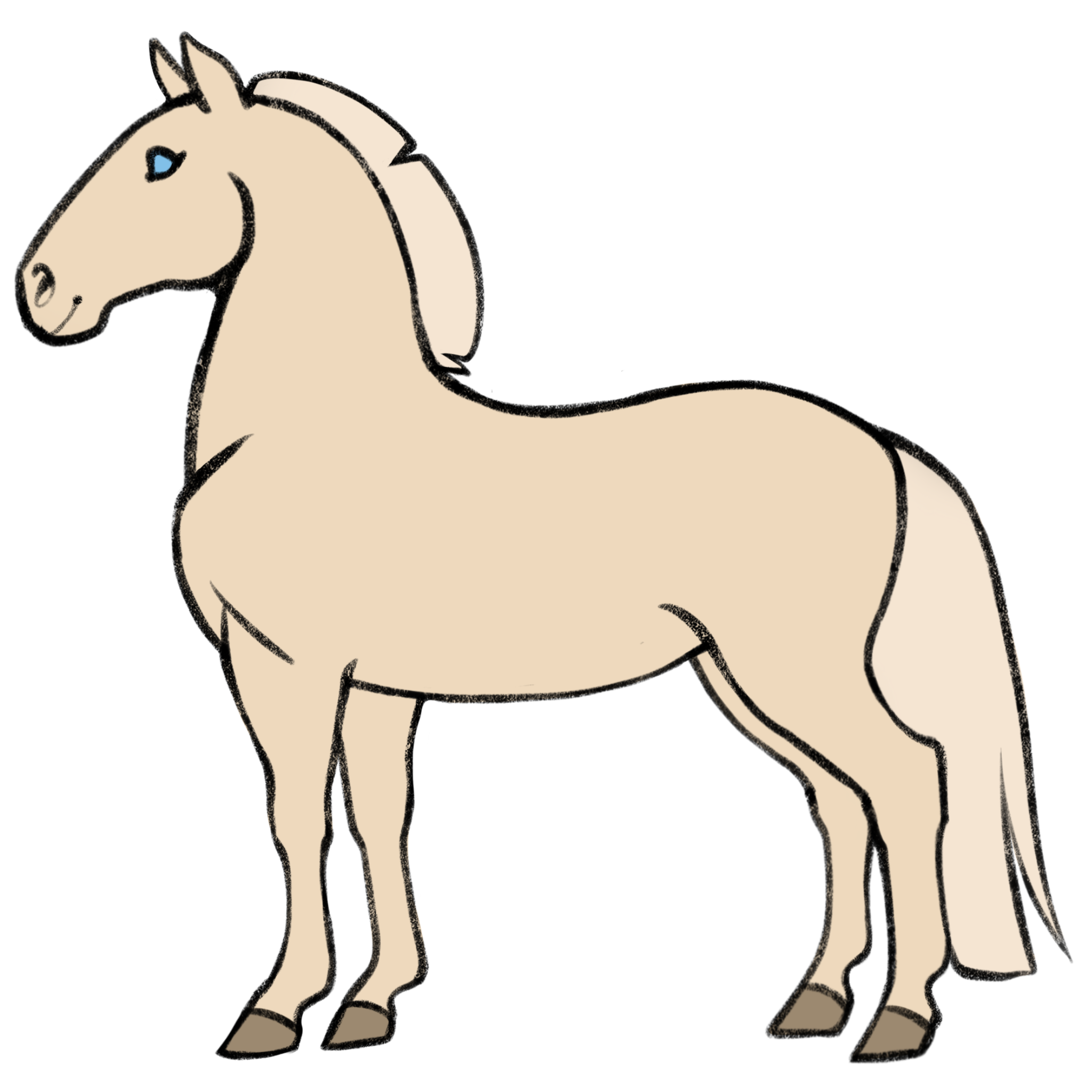
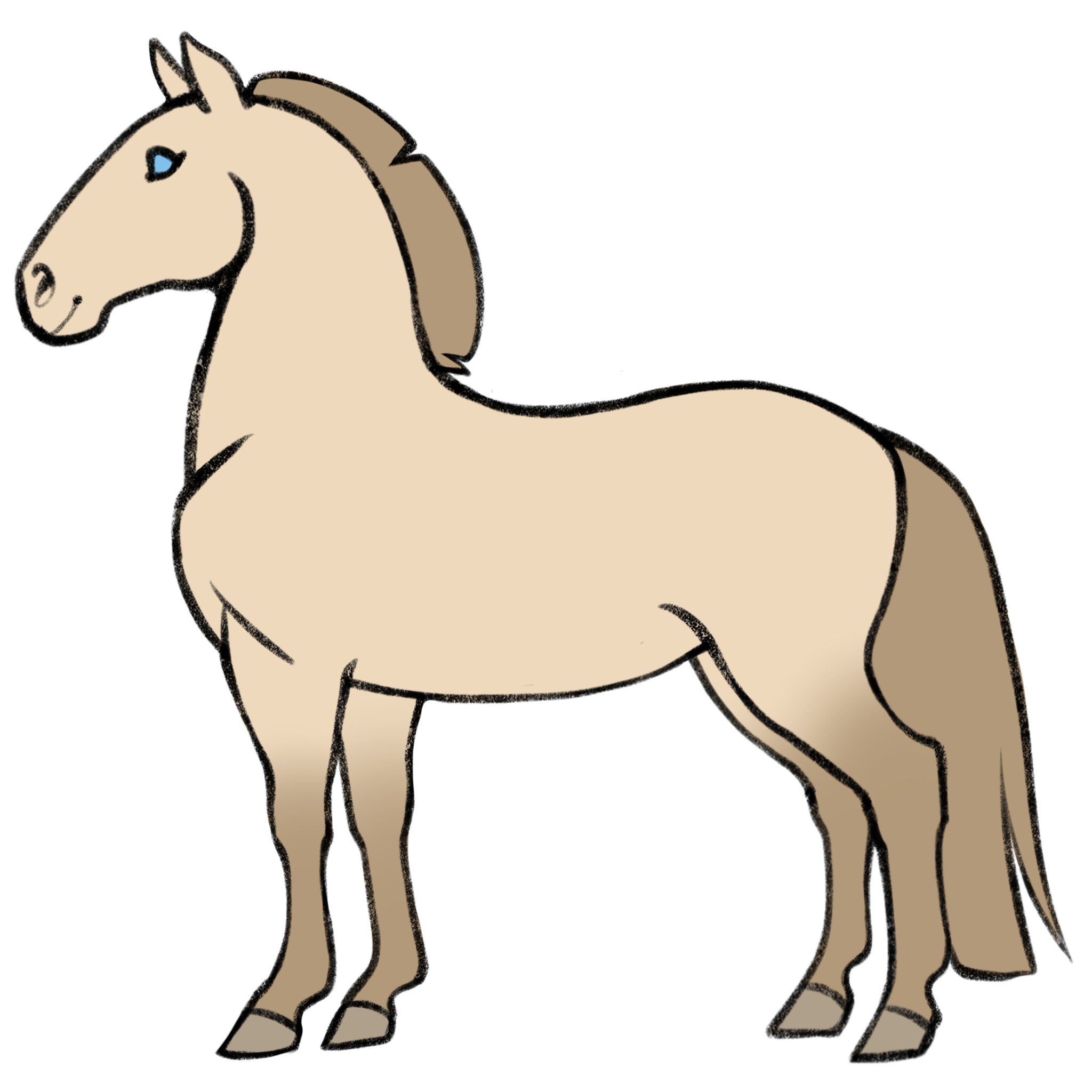

(D_) dun (Natural)
Name: Dun
Base Genotype: D_
Skin Color: No effect.
Eyes: No effect.
Description: Dun lightens all pigments in the coat, but only on the neck and body of the horse. Dun also causes a dorsal stripe down the horse's back and striping on the legs, which may cause bi-colored manes and tails. Dun is a dominant gene, so only one copy is required for it to be visible. Dun has several names for it's variations, which can all be searched on for real-life references:
- "Strawberry Dun" or "Red Dun" : a chestnut horse with dun
- "Bay Dun" or "Classic Dun" : a bay horse with dun
- "Grulla/Grullo" or "Blue Dun" : when a black horse has dun
Design Guidance: At minimum, the coat can be slightly lightened with a dorsal stripe present. At maximum, the coat is strongly lightened, with leg and dorsal striping. Striping can be black, if the horse has black pigment. Otherwise, the striping may be the base coat color that has been darkened. Lightening of the coat should not extend onto the horse's head, down past the knees, or down past the hocks on the hind legs. Horses may have different variations of the examples below:
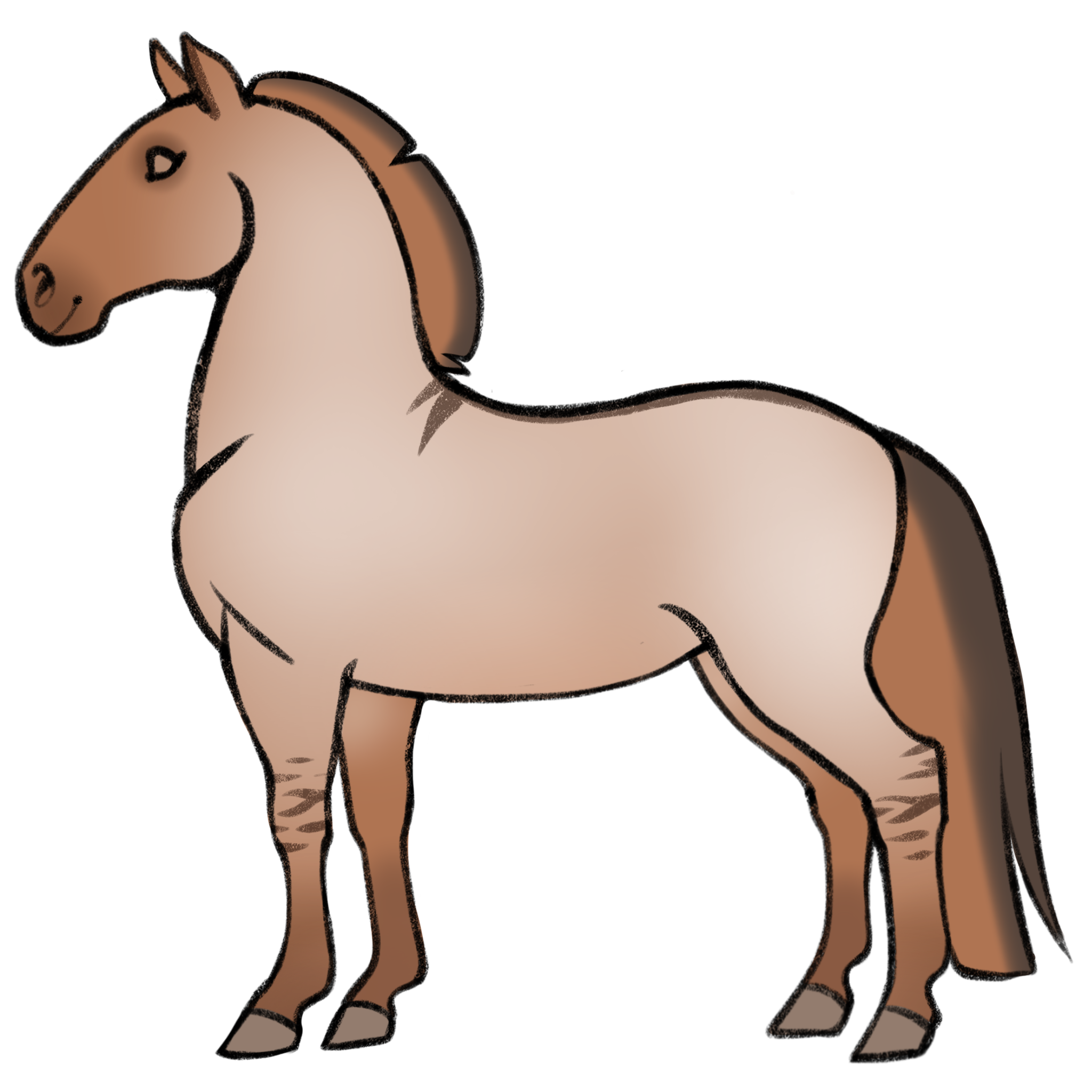

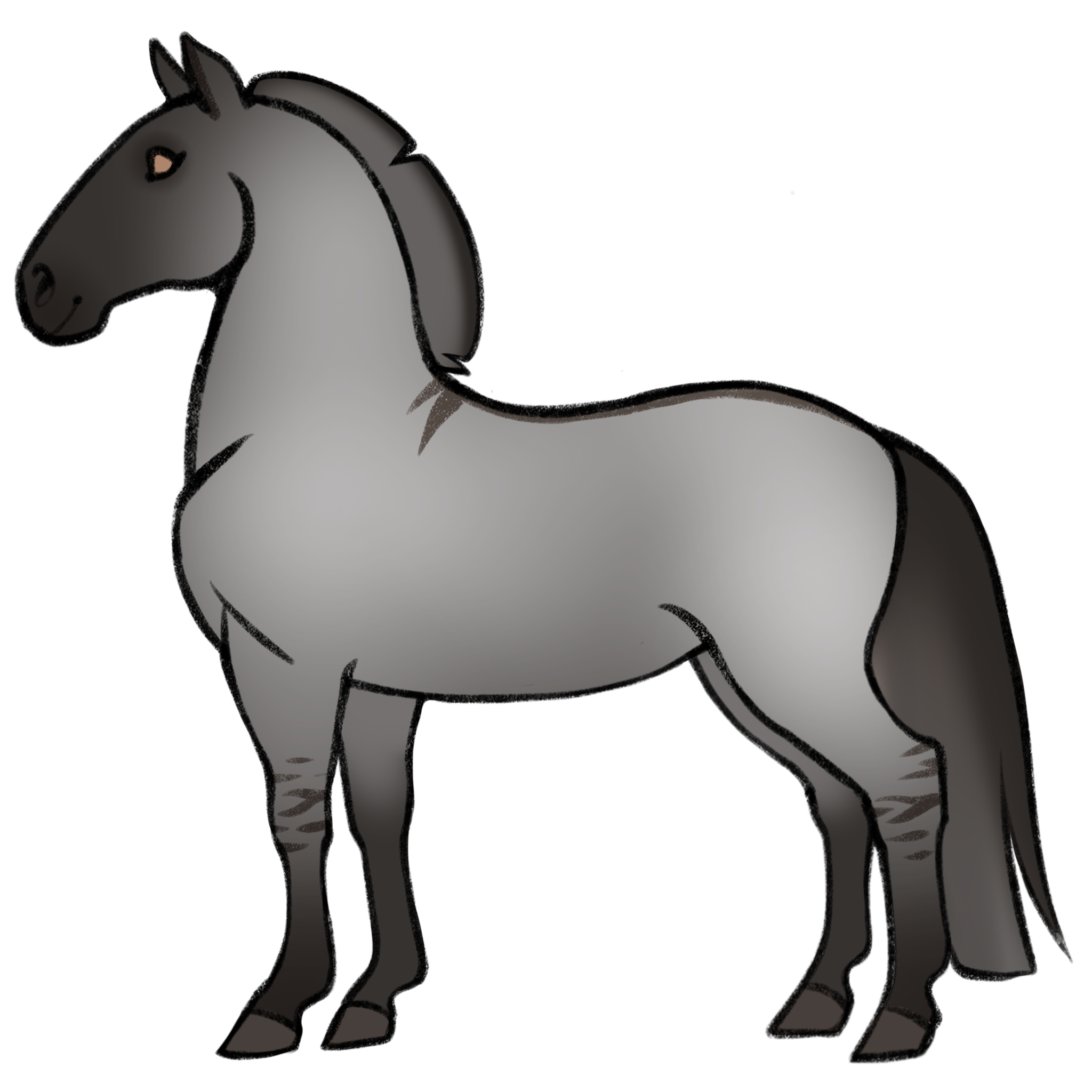
(prlprl) pearl (Natural)
Name: Pearl
Base Genotype: prlprl (on the same locus as Cream and Champagne)
Skin Color: Turns skin pink, regardless of base coat.
Eyes: Turns both eyes blue, unless a horse has an eye color gene such as Oracle, Arcane, or Tiger eye. If an eye color gene is present, it takes precedence and is visible. If an eye color gene is present, the designer has the option of choosing both eyes to take on the eye color gene, or just one (heterochromia).
Description: Pearl lightens all pigments in the coat, and is a recessive gene. This means two copies of pearl (prlprl) are required for it to be visible, or CRprl or CHprl will cause the horse appear as a double dilute very similar to double cream. When a horse carries one copy of pearl (prln) the coat is not affected. Pearl has several names for it's variations, which can all be searched on for real-life references:
- "Apricot" : a chestnut horse with double pearl
- "Bay Pearl" : a bay horse with double pearl
- "Black Pearl" : when a black horse has double pearl
Design Guidance: Double cream lightens the horse to an extreme degree and should have a slight yellow tone. It will make all hooves light in color. Double cream does not make horses pure white. Horses may have slighty different variations of the examples below, but not by much. Colorpicking is encouraged. Cream does interact with Grim and Ember; see dilution guides on their respective trait pages.



(CH_) champagne (Natural)
Name: Champagne
Base Genotype: CH_ (on the same locus as Cream and Pearl)
Skin Color: Turns skin pink, regardless of base coat. May cause freckling or mottling.
Eyes: Turns both eyes to a light honey brown or unsaturated green, unless a horse has an eye color gene such as Oracle, Arcane, or Tiger eye. If an eye color gene is present, the designer has the option of choosing both eyes to take on the eye color gene, or just one (heterochromia).
Description: Champagne lightens all pigments in the coat, and is an Dominant gene. This means that one copy of champagne (CHn) is all that is needed for this gene to be visible. If combined with another dilution copy on the same locus, such as pearl (CHprl) or cream (CRn CH_ or CRCR CH_) it will cause the horse appear as a double dilute very similar to double cream. Champagne has several names for it's variations, which can all be searched on for real-life references:
- "Gold Champagne" : a chestnut horse with champagne
- "Amber Champagne : a bay horse with champagne
- "Classic Champagne" : when a black horse has champagne
Design Guidance: Champagne lightens the horse to an extreme degree and should have a orange, brassy tone. It should be warmer and more saturated than Cream, and not as cool-toned as Pearl. Hooves may be light, dark, or striped. Horses may have slighty different variations of the examples below, but not by much. Colorpicking is encouraged. Champagne does interact with Grim and Ember; see dilution guides on their respective trait pages.
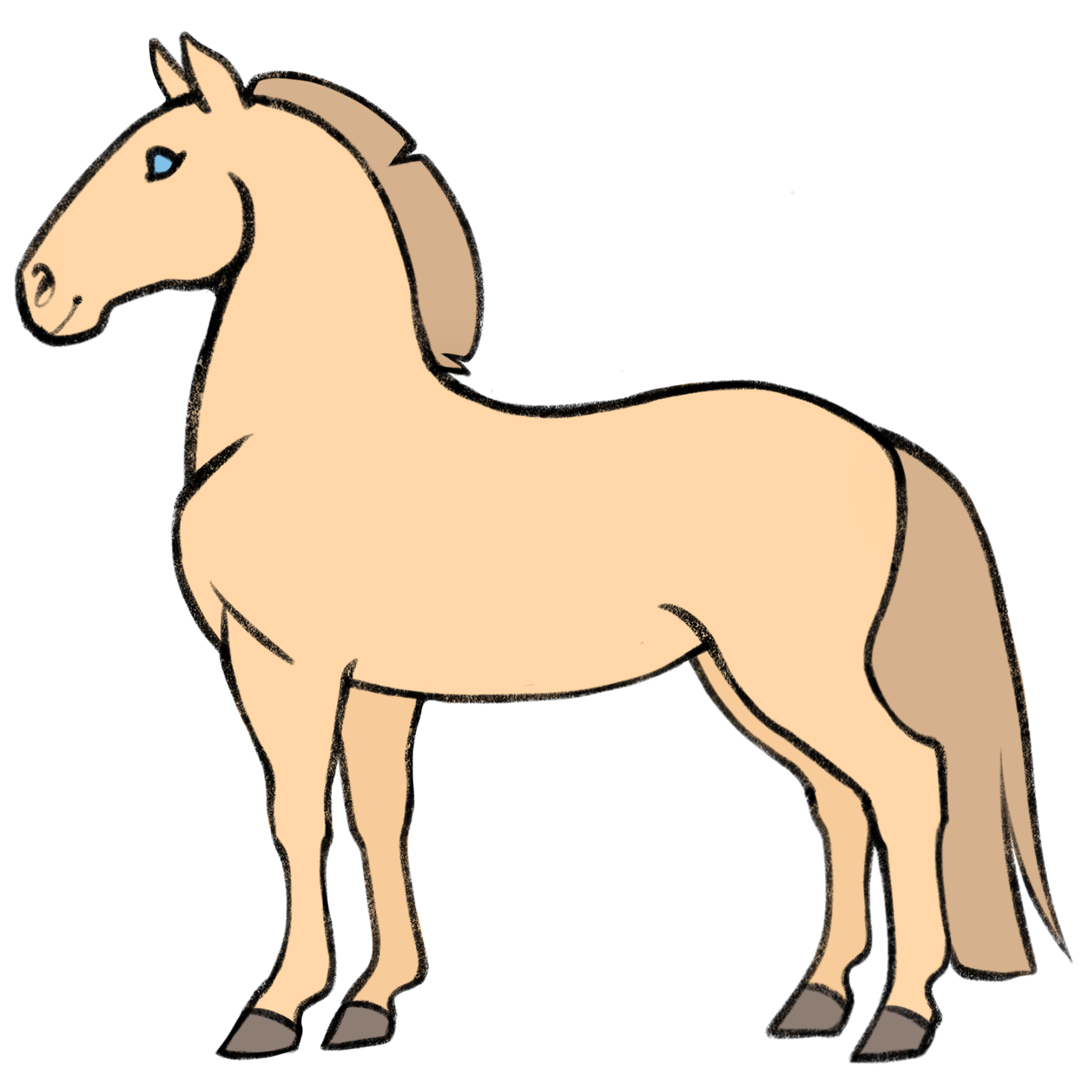
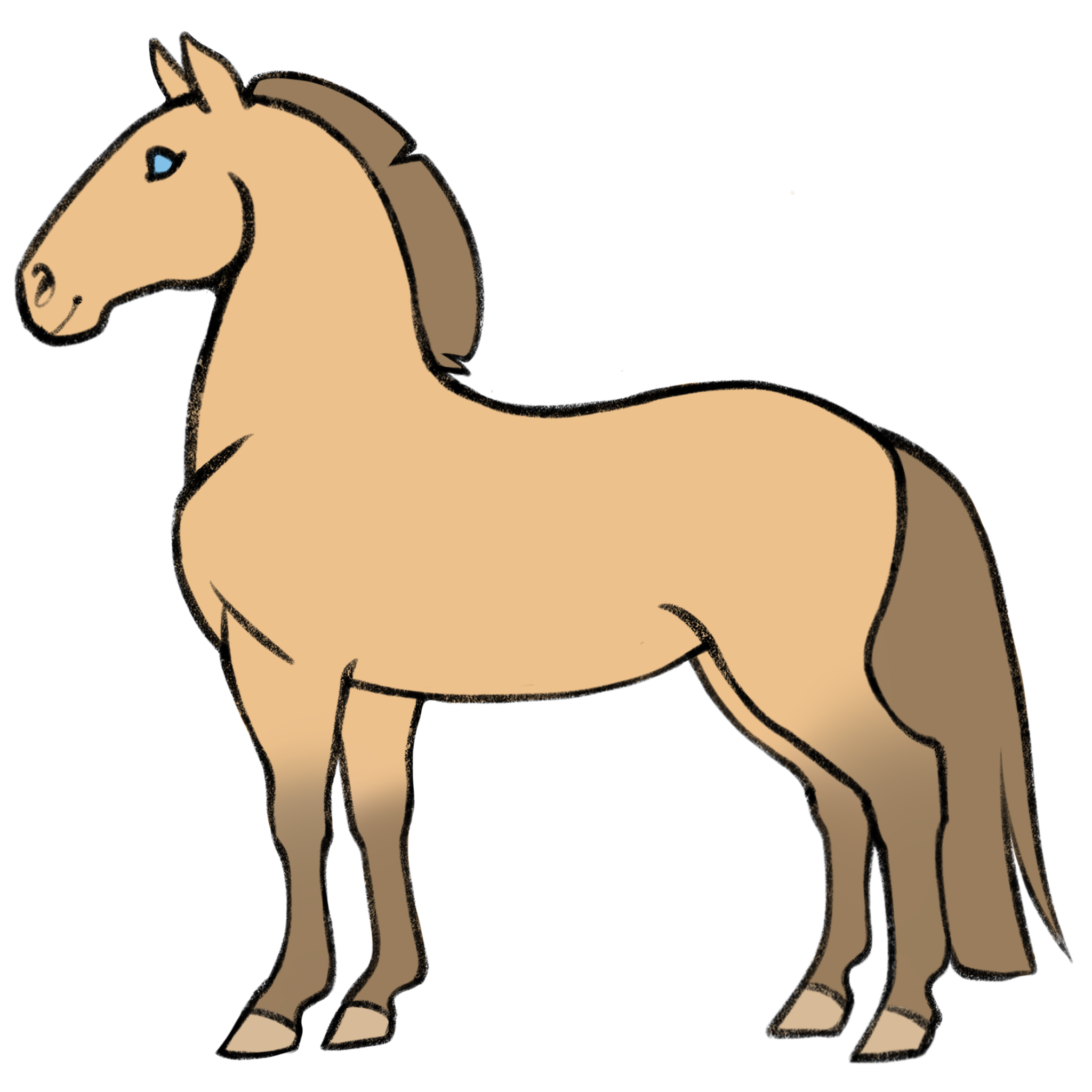

(CRn) single cream (Natural)
Name: Single Cream
Base Genotype: CRn (on the same locus as Champagne and Pearl)
Skin Color: No effect.
Eyes: No effect.
Description: Cream lightens the red pigments in the coat, and is an Incomplete Dominant gene. This means that one copy of cream (CRn) will look different from a horse with two copies of cream (CRCR). Cream does not affect black pigment. If combined with another dilution copy on the same locus, such as pearl (CRprl) or champagne (CRn CH_ ) it will cause the horse appear as a double dilute very similar to double cream. Cream has several names for it's variations, which can all be searched on for real-life references:
- "Palomino" : a chestnut horse with one copy of cream
- "Chocolate Palomino" : a very dark variation of palomino, could easily be mistaken for a liver chestnut with a flaxen mane.
- "Buckskin" : a bay horse with one copy of cream, can resemble a dun horse, but will have no leg striping or dorsal stripe.
- "Buttermilk Buckskin" : a lighter variation of buckskin.
- "Silver Buckskin" : the lightest variation of buckskin.
- "Smoky Black" : when a black horse has one copy of cream, it is barely noticeable.
Design Guidance: Single cream has a wide range of color, but is always visible unless the horse is black. Horses may have lighter/darker variations of the examples below. Cream does interact with Grim and Ember; see dilution guides on their respective trait pages.



A chocolate palomino horse can be as dark as this example, but no darker: 
(LPLP) hom. leopard complex (Natural)
Name: Homozygous Leopard Complex
Base Genotype: LPLP (no PATN, single PATN, or two PATNPATN)
Skin Color: Solid or mottled where leopard spotting touches skin.
Eyes: Brown or Blue
Description: One copy of LP by itself is the switch that flips on any "patn" genes present, and allows them to be expressed.
- If there are no patn genes present, then the horse exhibits "Varnish Roan" - a type of roan that causes white hairs to grow in over the course of the horse's life, and is generally unstable (similar to grey). Varnish roan may cover the entire body, face, and legs, or be rather faint and patchy.
- If one patn gene is present, the horse exhibits a strong frosting of white hairs known as a "snowcap" that starts at the rump and can cover from the rump to the shoulders at maximum. Snowcaps will occasionally have very small spots of base coat visible through them, but should primarily be solid white with frosted out edges. (Unlike blanket markings, which have crispy edges and can have large spots.) These horses may have lighter vanish roaning over their body, which can also feature small spots if desired.
- If two copies of the patn gene is present, the horse is a "Fewspot" and the entire body is white, with small spots that reveal the base coat beneath the white. These spots should mostly not exceed the size of the horses eye.
The Leopard Complex also causes mottled skin and striped hooves where spots touch the coronet band. If white touches the eye, the eyes can be blue or exhibit heterochromia. Leopard patterns can also exist alongside other white patterning, such as tobiano or overo, to create "pintaloosa" patterns.
Examples of a bay varnish roan, a bay snowcap, and a bay fewspot.



(nLP) het. leopard complex (Natural)
Name: Heterozygous Leopard Complex
Base Genotype: nLP (no PATN, single PATN, or two PATNPATN)
Skin Color: Solid or mottled where leopard spotting touches skin.
Eyes: Brown or Blue
Description: One copy of LP by itself is the switch that flips on any "patn" genes present, and allows them to be expressed.
- If there are no patn genes present, then the horse exhibits "Snowflake" - a type of white spotting that covers the horse's body, similar to birdcatcher spots, but can vary in size and number and tend to be larger and more numerous than birdcatcher spots.
- If one patn gene is present, the horse exhibits a "Semi-Blanket" pattern, with crispy edges, that starts at the rump and can cover from the rump to the shoulders at maximum. Varnish-style roaning can also be present on the body, face, and legs of the horse. This roaning can also feature spots. These spots can be ringed with a lighter rings of roan to create a leopard complex variation known as "Peacock Appaloosa" on a horse.
- If two copies of the patn gene is present, the horse is "Full Blanket" and the entire body is white, with medium to large spots that reveal the base coat beneath the white.
The Leopard Complex also causes mottled skin and striped hooves where spots touch the coronet band. If white touches the eye, the eyes can be blue or exhibit heterochromia. Leopard patterns can also exist alongside other white patterning, such as tobiano or overo, to create "pintaloosa" patterns.
Examples of a chestnut snowflake, a black base with a semi-blanket pattern (this horse also has light "peacocking" on the roan spots), and a bay horse with a full blanket pattern.
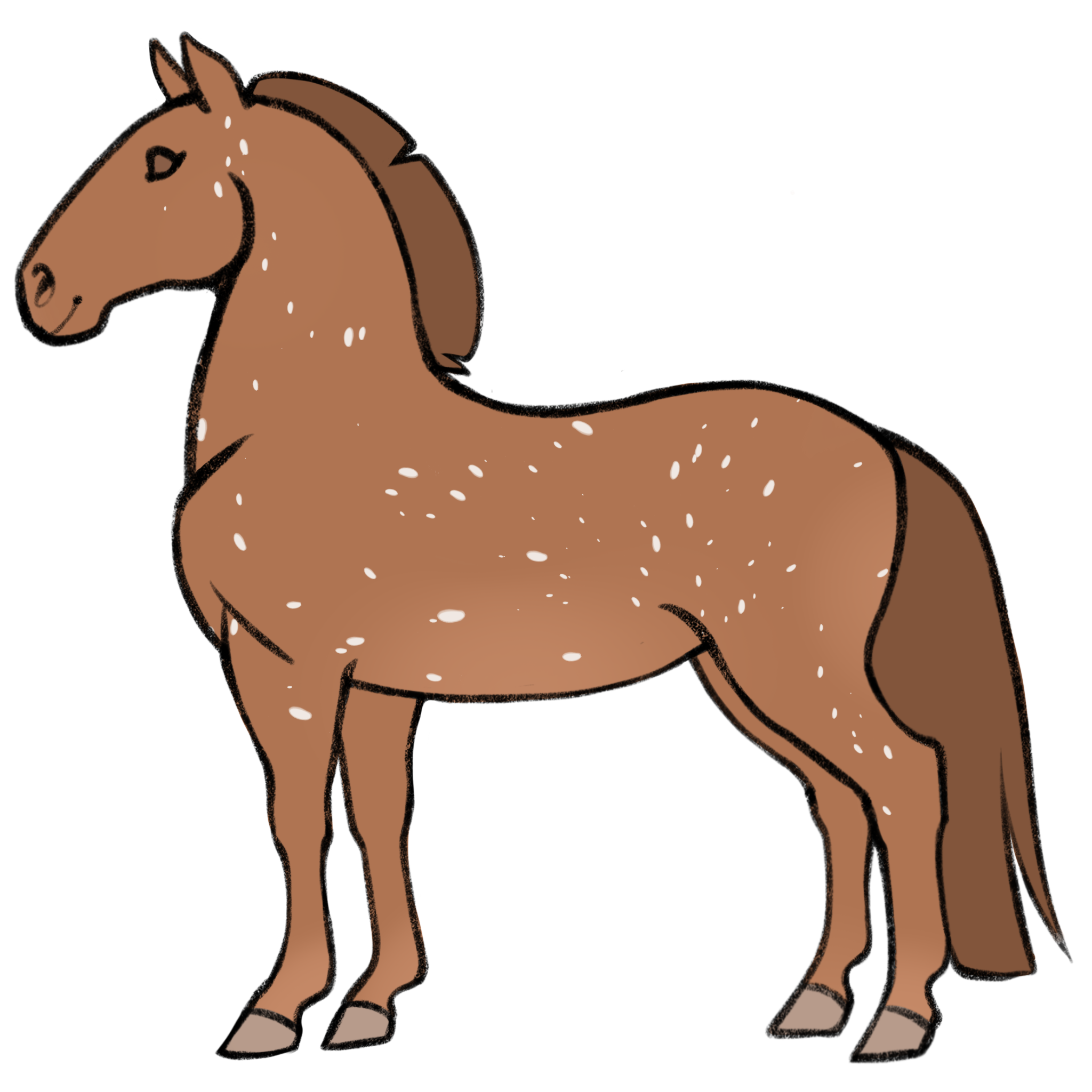
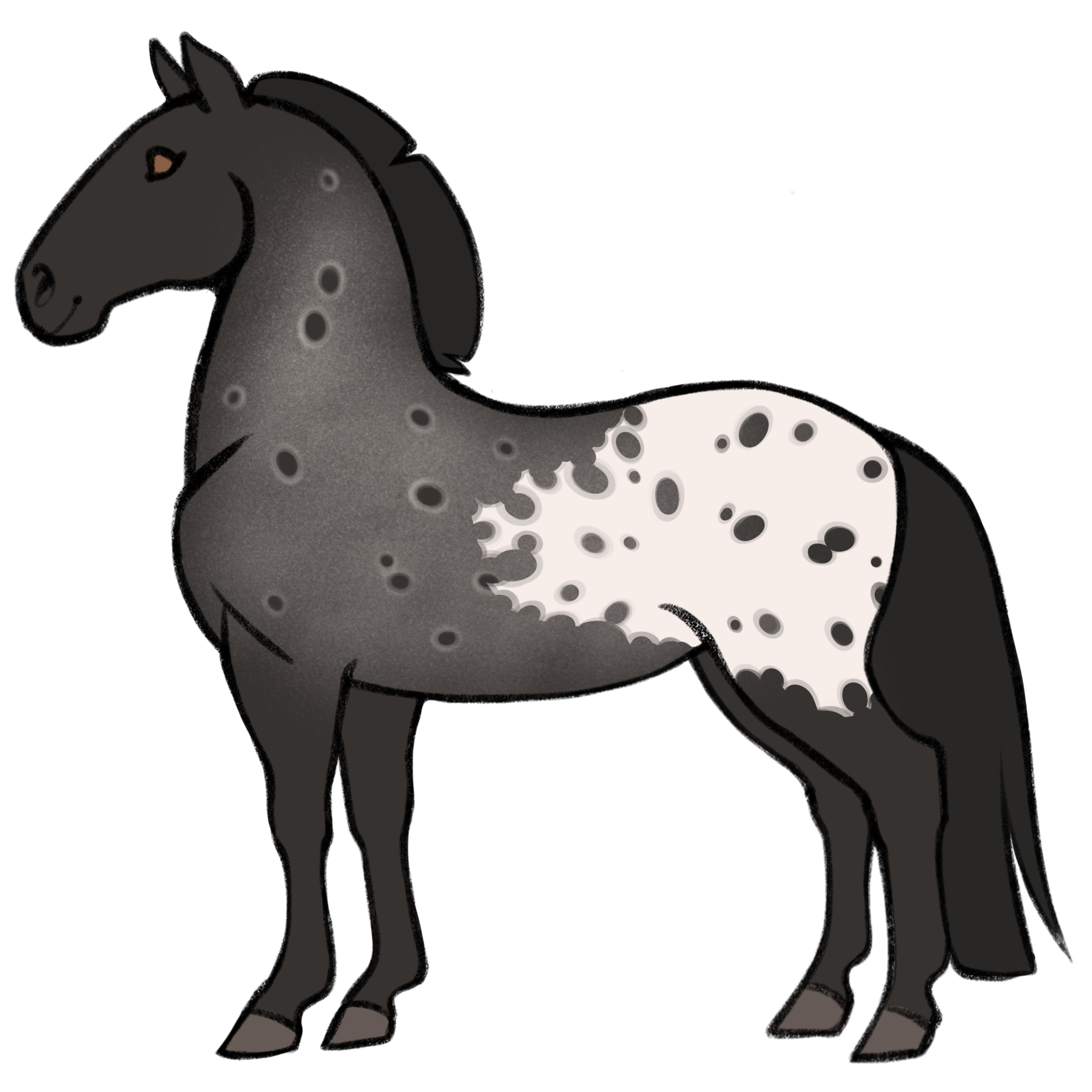
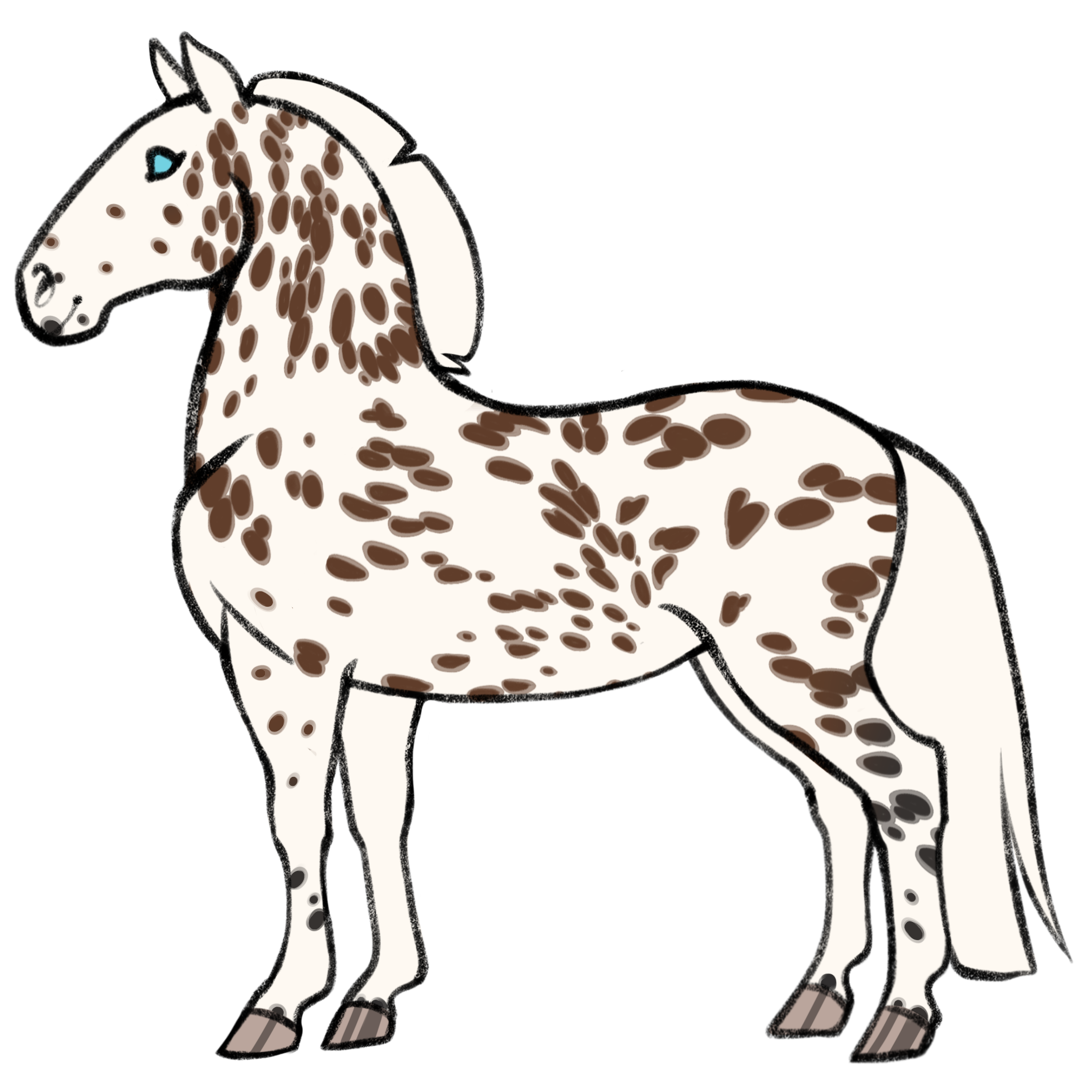
(G_) grey (Natural)
Causes the horse to grow grey or white hairs all over their body, causing the horse to go from their base coat color to grey or white over the course of their lifetime, with most horses becoming totally grey by 10 years old at the latest. Grey may be fleabitten grey or dapple grey varieties.
(rbrb) rabicano (Natural)
Name: Rabicano
Base Genotype: rbrb
Skin Color: Skin becomes pink under white markings.
Eyes: No effect.
Description: Rabicano is a recessive trait that requires two copies to show on the horse. It's characterized by roaning centered around the horse's flank and groin, with some of the roaning concentrating into striping that wraps around the horse's barrel. May also cause tail frosting at the base of the tail.
Design Guidance: Rabicano should have a frosted appearance. Stripes should not be "hard" striping as seen on zebras or dun, but softly concentrated striping. Minimal rabicano can be invisible. Maximum rabicano looks like the example below.

(W_) dominant white (Natural)
Name: Dominant White
Base Genotype: W_
Skin Color: Skin becomes pink under white markings.
Eyes: Blue eyes, unless an eye color gene is present, such as Tiger, Oracle, or Arcane. Those genes will take precedence.
Description: The entire horse is white, obscuring all other coat colors, modifiers, and other white patterns. Although these horses have white ears, they are not deaf like is the case with Tobiano, Overo, or other white-patterned horses.
Design Guidance: At minimum, the entire horse is white. At maximum the entire horse is white. There is no other expression of this gene.
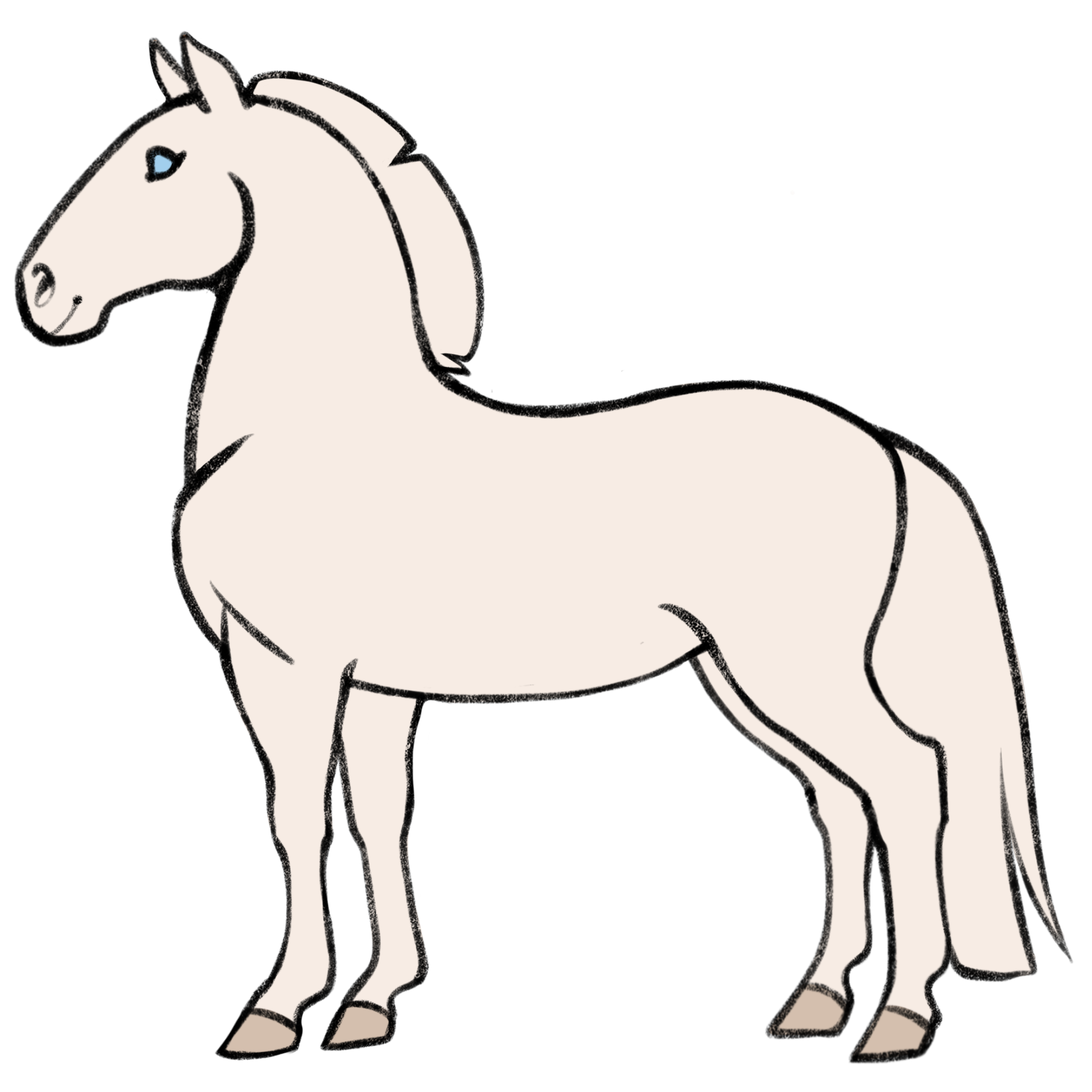
(SB_) sabino (Natural)
Name: sabino
Base Genotype: SB_
Skin Color: Skin becomes pink/mottled to match the mottled white markings.
Eyes: If a white marking touches an eye, it becomes blue. Heterochromia is common.
Description: Sabino causes large white patches to appear from the legs of the horse and upwards, just like Splash, except Sabino causes extreme mottling or "frosting" of the white pattern and roaning of the coat. Sabino roaning may cross the back of the horse, but the bulk of the white pattern originates from the legs and belly. Facial markings are usually large and frosted around the edges. Mottling of skin will occur wherever the white frosting turns the skin pink. Keep in mind that if a white patch turns the ears of the horse white, the horse is highly likely if not guaranteed to be deaf!
Design Guidance: At minimum, sabino can be invisible, or have mottled white leg and face markings.
At maximum, the white covers up to 75% of the horse from the bottom up, with the bulk of the white favoring the legs and belly. Edges of the white pattern are mottled dots or otherwise jagged. Ears are rarely turned white, but it happens (and may cause deafness). The mane and tail will turn white where white patterns touch. Skin becomes light colored where white patterns touch.
Examples of a chestnut sabino with minimal markings, a bay sabino with average markings, and a black sabino with more maximal markings.
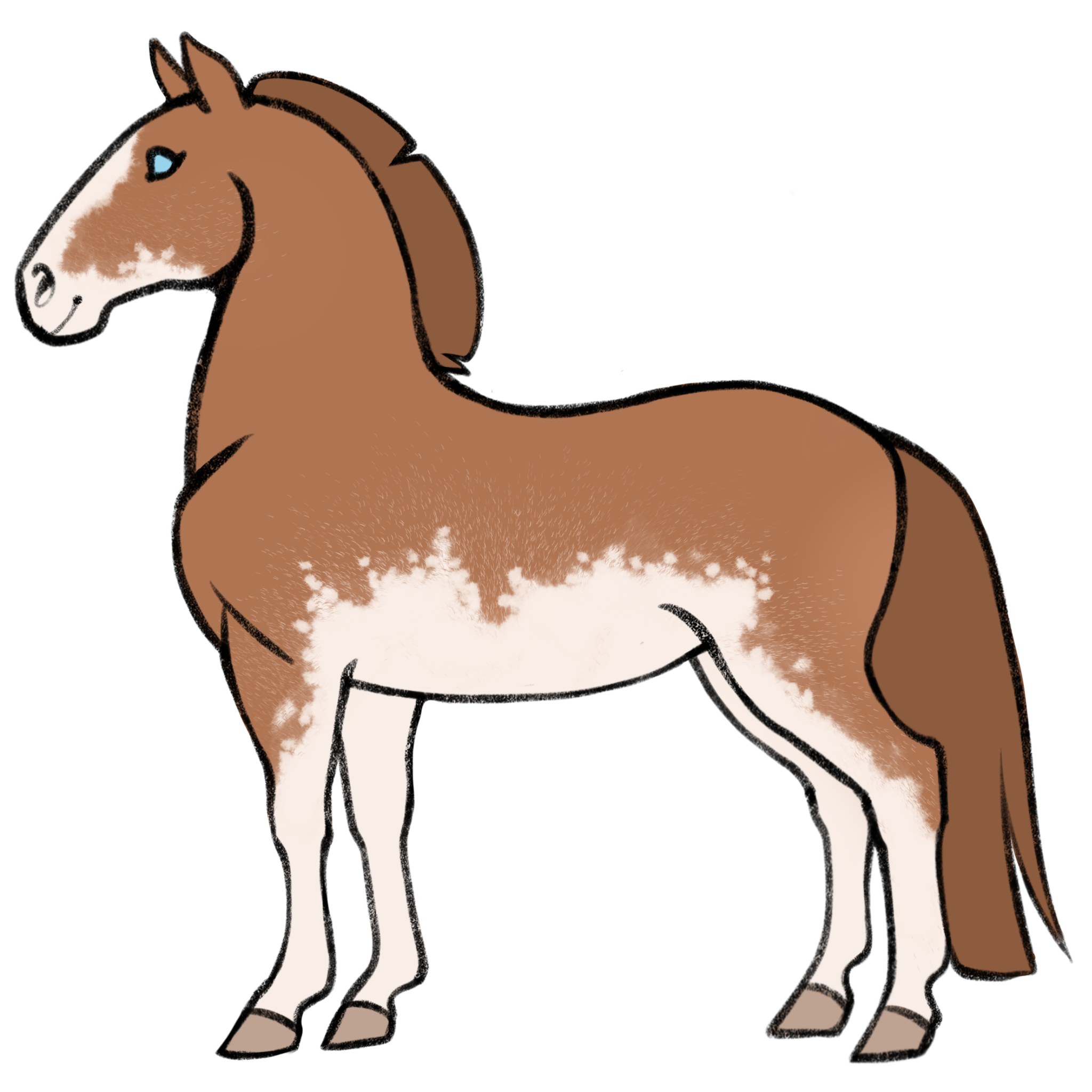
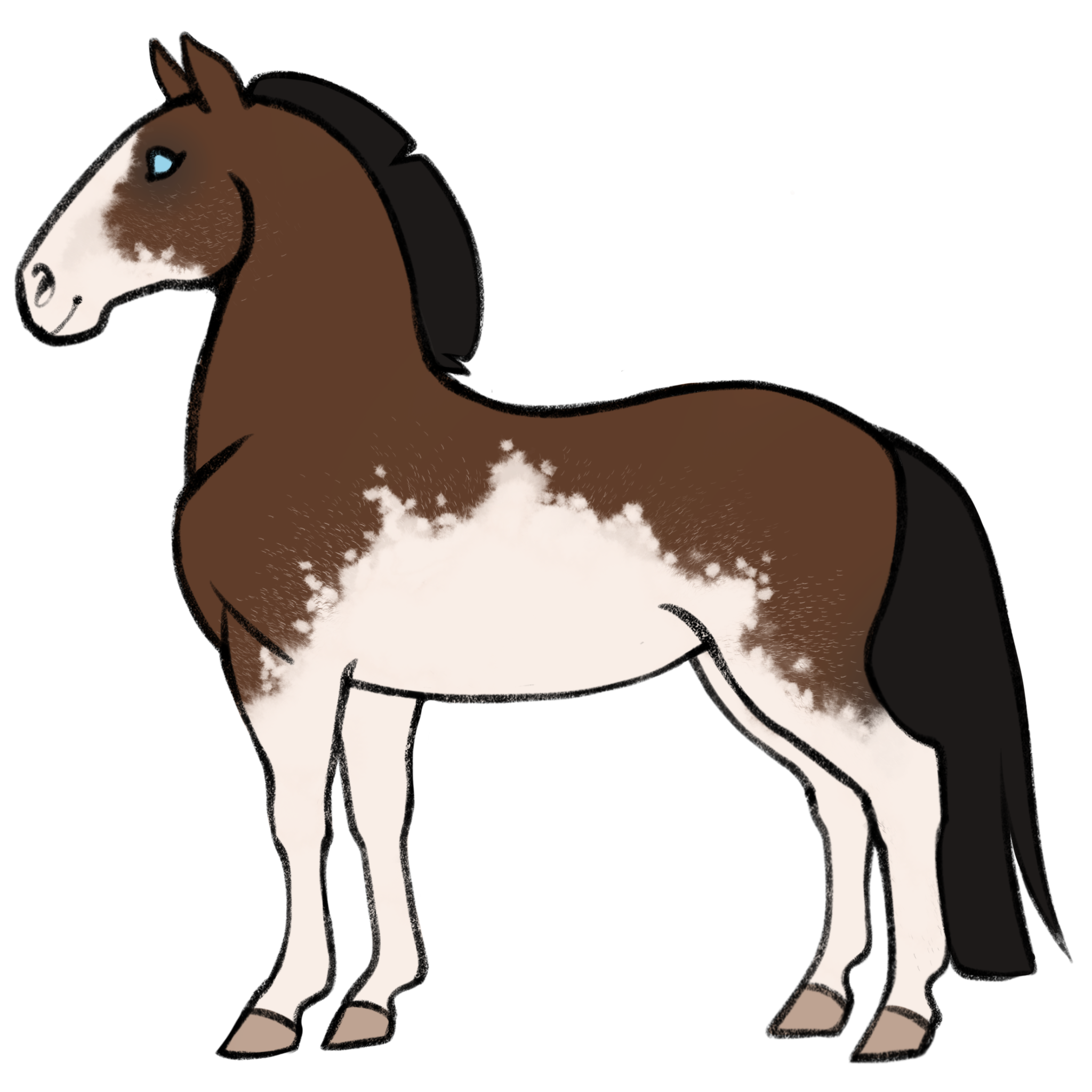

(SPL_) splash (Natural)
Name: splash
Base Genotype: SPL_
Skin Color: Skin becomes pink under white markings.
Eyes: If a white marking touches an eye, it becomes blue. Heterochromia is common.
Description: Splash causes large white patches to appear from the legs of the horse and upwards, as if the horse has been dipped in white paint! Splash by itself will never cross the back of the horse. Facial markings are usually large and striking. Keep in mind that if a white patch turns the ears of the horse white, the horse is highly likely if not guaranteed to be deaf!
Design Guidance: At minimum, the horse must have four white coronet bands. Must have a white marking on the face, such as a snip, blaze, badgerface, or baldface; any facial markings are allowed, not just minimal natural facial markings such as with tobiano.
At maximum, the white covers the entirey of the horse, but still does not cross over the horse's spine. Edges of the white pattern are smooth and sloping, with no spots of base color within the patch. Ears are rarely turned white, but it happens (and may cause deafness). The mane and tail will turn white where touched. Skin becomes light colored where white patterns touch.
Examples of a chestnut splash with maximal markings, a bay splash with average markings, and a black splash with more minimal markings.
